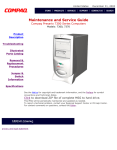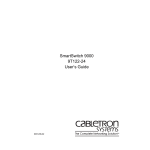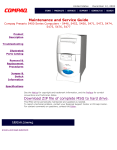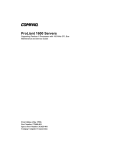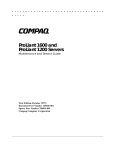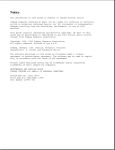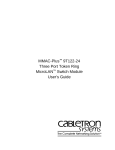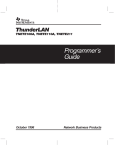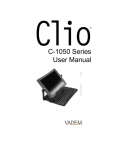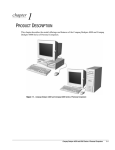Download NOTICE
Transcript
NOTICE The information in this guide is subject to change without notice. COMPAQ COMPUTER CORPORATION SHALL NOT BE LIABLE FOR TECHNICAL OR EDITORIAL ERRORS OR OMISSIONS CONTAINED HEREIN; NOR FOR INCIDENTAL OR CONSEQUENTIAL DAMAGES RESULTING FROM THE FURNISHING, PERFORMANCE, OR USE OF THIS MATERIAL. This guide contains information protected by copyright. No part of this guide may be photocopied or reproduced in any form without prior written consent from Compaq Computer Corporation. © 1995 Compaq Computer Corporation. All rights reserved. Printed in the U.S.A. Compaq, Systempro, Deskpro, Compaq Insight Manager, Registered U.S. Patent and Trademark Office. ProSignia, Systempro/XL, ProLiant, NetFlex, ROMPaq, and QVision are trademarks of Compaq Computer Corporation. The software described in this guide is furnished under a license agreement or nondisclosure agreement. The software may be used or copied only in accordance with the terms of the agreement. Product names mentioned herein may be trademarks and/or registered trademarks of their respective companies. MAINTENANCE AND SERVICE GUIDE Compaq ProLiant 4500 Servers First Edition (May 1995) Text Number 188470-001 CHMP v PREFACE This Maintenance and Service Guide is a troubleshooting guide that can be used for reference when servicing the Compaq ProLiant Family of Servers. Compaq Computer Corporation reserves the right to make changes to Compaq ProLiant 4500 Servers without notice. Symbols The following text and symbols mark special messages throughout this guide: WARNING: Text set off in this manner indicates that failure to follow directions in the warning could result in bodily harm or loss of life. CAUTION: Text set off in this manner indicates that failure to follow directions could result in damage to equipment or loss of data. IMPORTANT: Text set off in this manner presents clarifying information or specific instructions. NOTE: Text set off in this manner presents commentary, sidelights, or interesting points of information. Technician Notes WARNING: Only authorized technicians trained by Compaq should attempt to repair this equipment. All troubleshooting and repair procedures are detailed to allow only subassembly/module level repair. Because of the complexity of the individual boards and subassemblies, no one should attempt to make repairs at the component level or to make modifications to any printed wiring board. Improper repairs can create a safety hazard. Any indications of component replacement or printed wiring board modifications may void any warranty. CAUTION: To properly ventilate your system, you must provide at least 12 inches (30.48 cm) of clearance at the front and back of the computer. CAUTION: The computer is designed to be electrically grounded. To ensure proper operation, plug the AC power cord into a properly grounded AC outlet only. Maintenance and Service Guide vi Preface Locating Additional Information The following documentation is available to support these products: n User Documentation n Compaq Service Quick Reference Guide n Service Training Guides n Compaq Service Advisories and Bulletins n Compaq QuickFind n Compaq Insight Manager 2.0 Maintenance and Service Guide vii CONTENTS Chapter 1 ILLUSTRATED PARTS CATALOG Compaq ProLiant 4500 Server 1-1 Mechanical Exploded View of the Compaq ProLiant 4500 Components Exploded View of the Compaq ProLiant 4500 1-1 1-2 Spares Parts List 1-3 Chapter 2 REMOVAL AND REPLACEMENT PROCEDURES ELECTROSTATIC DISCHARGE INFORMATION 2-1 PREPARATION PROCEDURES 2-2 POWER SUPPLY SAFETY INTERLOCK 2-2 REMOVAL AND REPLACEMENT PROCEDURES 2-3 Front Bezel Door/Side Access Panel System Unit Cover 2-3 2-4 Mass Storage Devices 2-5 Removable Media Storage Devices Hot-Pluggable Hard Drives 2-5 2-7 Important Guidelines About Replacing Hot-Pluggable Hard Drives 2-7 Replacing Hot-Pluggable Drives 2-8 Cable Folding Routing Diagrams 2-9 Cable Diagram for Diskette Drive Cable Diagram for Removable Media Storage Devices 2-9 2-10 Cable Diagram for Internal Fast-Wide SCSI-2 Device 2-10 Boards 2-11 Hot-Pluggable Drive Backplane Board 2-11 Memory 2-12 System Board 2-14 Processor Board 2-15 Option Boards 2-16 Power Supply Miscellaneous Parts 2-17 2-18 Rear Fan Lower Front Fan 2-18 2-19 Plenum Fan 2-20 Battery/Clock Module 2-21 Maintenance and Service Guide viii Contents Chapter 3 DIAGNOSTIC TOOLS Utility Access 3-1 POWER-ON SELF-TEST (POST) 3-2 POST Error Messages 3-3 DIAGNOSTICS (DIAGS) 3-13 Diagnostic Error Codes 3-13 DRIVE ARRAY ADVANCED DIAGNOSTICS (DAAD) Starting DAAD DAAD Diagnostic Messages RAPID RECOVERY SERVICES 3-25 3-25 3-26 3-35 Automatic Server Recovery Configuring the Server for Automatic Server Recovery (ASR) 3-35 3-37 Server Health Logs 3-39 System Configuration History Files 3-41 ROMPaq Chapter 4 SWITCH AND JUMPER INFORMATION SYSTEM BOARD System Maintenance Switch Settings SW1 SCSI DEVICES COMPAQ NETFLEX-2 CONTROLLER Chapter 5 PHYSICAL AND OPERATING SPECIFICATIONS System Unit Specifications 3-41 4-1 4-2 4-2 4-5 5-2 Power Supply Specifications 5-3 Redundant Power Supply Specifications 5-4 SIMM Specifications 5-5 Internal Diskette Drives 5-5 CD-ROM Specifications 5-6 SMART SCSI Array Controller 5-7 550-MB Pluggable Fast-SCSI-2 Drive Specifications 5-7 1.05-GB Pluggable Fast-SCSI-2 Drive Specifications 5-7 Maintenance and Service Guide Contents ix Chapter 5 Continued... 2.1-GB Pluggable Drive Specifications 4.3-GB Pluggable Drive Specifications 5-8 5-8 Integrated Fast-Wide SCSI-2 Controller 5-8 32-Bit Fast-Wide SCSI-2/E Controller 5-9 Integrated Fast-SCSI-2 Controller 5-9 32-Bit Fast-SCSI-2 Controller 5-9 NetFlex-2 ENET-TR Controller 5-10 NetFlex-3/E Controller 5-10 Maintenance and Service Guide Chapter 1 1-1 ILLUSTRATED PARTS CATALOG This chapter provides the illustrated parts breakdown and a spare parts list for the family of Compaq ProLiant 4500 Servers. Figure 1-1. Exploded View of the Compaq ProLiant 4500 Server Mechanical Parts Maintenance and Service Guide 1-2 Illustrated Parts Catalog Figure 1-2. Exploded View of the Compaq ProLiant 4500 Server System Components Maintenance and Service Guide Illustrated Parts Catalog 1-3 Table 1-1 Spares Parts List - Compaq ProLiant 4500 Item Description CHASSIS 1 Chassis 2 Hood 3 Side Access Panel 4 Front Bezel Door 5 Speaker 6 Power Supply/Inter-Lock Switch 7 Bezel Kit (1/6, 1/3, 1/2 Height - Qty 5 each) and Empty HotPluggable Drive Cover 8 Foot 9 System Fan 10 Chassis Brace with Board Guide (3 parts) 11 Plenum Fan 12 Lower Front Fan (under drive cage) 13 Modem Bracket 14 Key-Lock Assembly 15 Thumb Screw Assembly (Qty 3) 16 Front Bezel Guides (Qty 5) 17 Board Guide (Lower) 18 Board Guide for Processor and Memory (Rear Fan) 19 Bezel Switch Cover 20 Logo Kit (Qty 2) 21 Drive Guide and Ground Spring (Qty 5 each) 22 Slot Cover (Qty 5) 23 SCSI Cover SYSTEM COMPONENTS 24 Power Supply 25 Redundant Power Supply 488 W (Option) BOARDS 26 System I/O Board 27 Processor Board 5/100 MHz 28 Hot-Pluggable Drive Backplane Board (Wide SCSI) 29 Pass-Thru Board (Wide SCSI) MEMORY 30 Memory Expansion Board 31 4-MB SIMM (80ns) 8-MB SIMM (80ns) 16-MB SIMM (80ns) 32-MB SIMM (80ns) 4-MB SIMM (70ns) 8-MB SIMM (70ns) 16-MB SIMM (70ns) 32-MB SIMM (70ns) 64-MB SIMM (70ns) 4-MB SIMM (60ns) Part Number 199731-001 148593-001 148592-001 188487-001 148590-001 148583-001 211449-201 148580-001 148581-001 199732-001 199728-001 189916-001 148723-001 148725-001 148594-001 148724-001 148744-001 199733-001 148745-001 188488-001 146771-001 141081-001 190170-001 188406-001 163828-001 188414-001 184793-001 188490-001 199612-001 139947-001 118741-001 128954-001* 139143-001* 139949-001* 141754-001* 141755-001* 149947-001* 149948-001* 188489-001* 139139-001* Continued Maintenance and Service Guide 1-4 Illustrated Parts Catalog Spares Parts List - Compaq ProLiant 4500 Continued Item Description 8-MB SIMM (60ns) 16-MB SIMM (60ns) 32-MB SIMM (60ns) MASS STORAGE 33 550 MB Pluggable Fast-SCSI-2 Drive 34 1.05 GB Pluggable Fast-SCSI-2 Drive 35 2.1 GB Pluggable Fast-SCSI-2 Drive 36 4.3 GB Pluggable Fast-SCSI-2 Drive 37 2.1 GB Pluggable Fast-Wide SCSI-2 Drive 38 4.3 GB Pluggable Fast-Wide SCSI-2 Drive 39 Hot-Pluggable Tray Adapter (Fast-Wide SCSI-2) 40 Hot-Pluggable Tray Adapter (Fast-SCSI-2) 41 Tray Load CD-ROM Drive 42 1.44 MB, 3.5" Diskette Drive (Standard) 43 1.44 MB, 3.5" Diskette Drive (Option) 44 1.2 MB, 5.25" Diskette Drive 45 2/8-GB DAT Drive 46 525-MB ACA Tape Drive 47 4/16-GB TurboDAT Drive 48 TurboDAT Autoloader 49 1.2-GB Tape Drive CABLE KITS 50 LED Cables 51 Internal Fast-Wide SCSI-2 Cable, 23” 52 2-Device Internal Cable with Terminator, 36” 53 Diskette Cable 54 External SCSI Signal Cable 6' 55 External 100-Pin to 50-Pin Cable 56 Loop Back Cable (2 CH NIC) 57 Loop Back Cable (NetFlex) 58 2 Channel Ethernet "Y" Cable KEYBOARDS 59 Keyboard, U.S. English Keyboard, U.K. English Keyboard, German Keyboard, French Keyboard, Italian Keyboard, Spanish Keyboard, Danish Keyboard, Norwegian Keyboard, Swedish/Finnish Keyboard, Swiss Keyboard, French Canadian Keyboard, Portuguese Keyboard, Turkish Keyboard, Greek Keyboard, Latin American * Not Shown ** Cables shown in chapter 2 of this guide Part Number 139140-001* 139141-001* 139142-001* 146799-001 146717-001 199428-001 199584-001* 199643-001* 199598-001* 199656-001* 146781-001 142223-201 144207-201 112565-001* 112566-001 142074-201 142073-201 199464-201 199466-201 199615-201* 148585-001 199606-003** 148728-001** 143706-001** 146776-001 142159-001 142254-001* 142054-001* 197134-001 160648-101* 160648-103* 160648-104* 160648-105* 160648-106* 160648-107* 160648-108* 160648-109* 160648-110* 160648-111* 160648-112* 160648-113* 160648-114* 160648-115* 160648-116* Continued Maintenance and Service Guide Illustrated Parts Catalog 1-5 Spares Parts List - Compaq ProLiant 4500 Continued Item Description Keyboard, Arabic Keyboard, Belgian Keyboard, BHCSY Keyboard, Hungary Keyboard, Polish Keyboard, Slovakia Keyboard, Russia Keyboard, Czech MISCELLANEOUS 60 Maintenance and Service Guide 61 Administrator's Guide, English Administrator's Guide, German Administrator's Guide, French Administrator's Guide, Italian Administrator's Guide, Spanish Administrator's Guide, Japanese Administrator's Guide, Dutch 62 System ROMpaq 63 Option ROMpaq 64 RTC Chip with Battery 65 Shipping Box 66 Shipping Buns and Plastic Bag 67 Power Supply Maintenance Key (Qty 5) 68 Drive Backplane ROM OPTIONS 69 SMART Controller 70 Fast-SCSI-2/E Controller 71 Fast-Wide SCSI-2/E Controller 72 NetFlex Controller 73 NetFlex-2 Controller 74 NetFlex-3/E Controller 75 NetFlex-3 100 Base-TX Upgrade Module 76 NetFlex-3 100 VG-AnyLAN Upgrade Module 77 Token Ring Module 78 DualPort Ethernet Controller 79 2400 Baud LTE Modem 80 2400 Baud LTE Modem (DAA) 81 SpeedPaq Modem (US only) * Not Shown Part Number 160648-117* 160648-118* 160648-120* 160648-121* 160648-122* 160648-123* 160648-124* 160648-129* 188491-001* 188485-001* 188485-041* 188485-051* 188485-061* 188485-071* 188485-191* 188485-331* 143198-001* 142207-001* 149344-001* 148577-001* 148726-001* 148757-001* 146705-001 181132-001 142040-001* 199634-001* 142041-001* 142222-001* 169801-001 169805-001 169803-001 142042-001* 142151-001 121250-001 127831-001* 199906-001 Maintenance and Service Guide Chapter 2 2-1 REMOVAL AND REPLACEMENT PROCEDURES This chapter provides subassembly/module-level removal and replacement procedures for the Compaq ProLiant 4500 Family of Servers. After completing all necessary removal and replacement procedures, run the DIAGNOSTICS program to verify that all components operate properly. NOTE: Refer to the support software guide for procedures on using the Compaq System Configuration utility when installing or removing expansion boards, mass storage devices, and Extended Industry Standard Architecture (EISA) options. To service Compaq ProLiant 4500 Servers, you need: n Torx T-15 screwdriver n Power Supply Service Maintenance Key n Ethernet loopback plug n NetFlex loopback plug n System Configuration software n Diagnostics software n Drive Array Advanced Diagnostics software ELECTROSTATIC DISCHARGE INFORMATION A discharge of static electricity can damage static-sensitive devices or microcircuitry. Proper packaging and grounding techniques are necessary precautions to prevent damage. To prevent electrostatic damage observe the following precautions: n Transport products in static-safe containers such as conductive tubes, bags, or boxes. n Keep electrostatic-sensitive parts in their containers until they arrive at static-free stations. n Cover work stations with approved static-dissipating material. Provide a wrist strap connected to the work surface and properly grounded tools and equipment. n Keep work area free of non-conductive materials such as ordinary plastic assembly aids and foam packing. n Always be properly grounded when touching a static-sensitive component or assembly. n Avoid touching pins, leads or circuitry. n Always place drives PCB assembly side down on the foam. n Use conductive field service tools. Maintenance and Service Guide 2-2 Removal and Replacement Procedures PREPARATION PROCEDURES Before beginning any of the removal and replacement procedures, complete the following steps: 1. Turn the computer and any peripheral devices off. 2. Disconnect the AC power cord from the AC outlet, then from the server. 3. Disconnect all external peripheral devices from the server. POWER SUPPLY SAFETY INTERLOCK The Compaq ProLiant 4500 Server is equipped with a safety interlock switch to minimize the risk of exposure to high voltage and maintain proper air flow for cooling of the processor and mass storage devices. When the side access panel is removed, the power supply is automatically disabled. This safety feature can be defeated with a Service Maintenance Key (Spares Part Number 148757-001) if power is required when servicing the server with the side access panel removed. WARNING: High voltage present. Extreme care must be taken when running the Compaq ProLiant 4500 Server with the system unit cover removed and the safety interlock defeated. CAUTION: The Compaq ProLiant 4500 Server should always be operated with the system unit cover on. Proper cooling will not be achieved with the system unit cover off. Figure 2-1. Power Supply Interlock Defeat Maintenance and Service Guide Removal and Replacement Procedures 2-3 REMOVAL AND REPLACEMENT PROCEDURES Front Bezel Door/Side Access Panel WARNING: High voltage present. Extreme care must be taken when running the Compaq ProLiant 4500 Server without the system unit cover on. Figure 2-2. Opening Front Bezel Door 1. Unlock front bezel door and swing open. Figure 2-3. Removing the Side Access Panel 2. Loosen slotted thumb screws at front panel. Maintenance and Service Guide 2-4 Removal and Replacement Procedures 3. Slide the side access panel forward and then lift out. 4. Reverse steps for replacing side access panel. System Unit Cover Figure 2-4. Removing the Front Bezel Door 1. Lift and remove the front bezel door. Figure 2-5. Removing the System Unit Cover 2. Unscrew and remove screws at front panel. 3. Slide system unit cover forward and then up. 4. Reverse steps for replacing system unit cover. Maintenance and Service Guide Removal and Replacement Procedures 2-5 Mass Storage Devices The Compaq ProLiant 4500 Server contains two areas for mass storage devices: the removable media area and the hot-pluggable hard drive bays. Figure 2-6. Mass Storage Device Locations and Bay Numbers Removable Media Storage Devices Table 2-1 shows the supported mass storage devices and their supported locations. Table 2-1 Removable Media Bay Configurations Mass Storage Device 1.44-MB, 3.5" Diskette Drive 1.2-MB, 5.25" Diskette Drive 2/8-GB Digital Audio Tape (DAT) Drive 525-MB ACA Tape Drive 4/16-GB Digital Audio Tape (DAT) Drive CD-ROM Drive 1.2-GB Tape Drive TurboDAT Drive w/ Autoloader (full height device requires both bays, 5 and 6) * CD-ROM drive in bay 5 must be removed. 7 ü Storage Bays 6 ü ü ü ü ü ü ü 5 ü* ü* ü* ü ü* ü* Maintenance and Service Guide 2-6 Removal and Replacement Procedures Figure 2-7. Removing a Storage Device from the Removable Media Area 1. Unlock and open the front bezel door. 2. Remove the side access panel. 3. Disconnect power and signal cables from rear of drive. 4. Remove retaining screws. 5. Slide mass storage device out. 6. Reverse steps for installation. Maintenance and Service Guide Removal and Replacement Procedures 2-7 Hot-Pluggable Hard Drives Hot-Pluggable hard drives used in combination with the Compaq Smart SCSI Array Controller can be replaced while the power is still on. NOTE: It is not necessary to set the SCSI ID jumpers on a Compaq replacement HotPluggable hard drive. The SCSI ID is set automatically by the backplane board and the Hot-Pluggable tray when the drive is installed. CAUTION: Before removing any Hot-Pluggable hard drive, read the guidelines listed in the following section. Important Guidelines About Replacing Hot-Pluggable Hard Drives When a drive configured for fault tolerance is replaced, the replacement drive will automatically begin being restored when it is installed. When a drive is in the process of being restored, the On-line LED will flash green. The LED will continue to flash until the drive is completely restored. Figure 2-8. Hot-Pluggable Hard Drive LED Indicators When replacing Hot-Pluggable hard drives, these guidelines must be followed: n Never remove more than one drive at a time. When a drive is replaced, the controller uses data from the other drives in the array to reconstruct data on the replacement drive. If more than one drive is removed, a complete data set is not available to reconstruct data on the replacement drive(s). n Never remove a working drive when another drive has failed. Drives that have been failed by the controller are indicated by the amber Drive Failure LED on the drive tray. Permanent data loss will occur if a working drive is removed when replacing a failed drive. Maintenance and Service Guide 2-8 Removal and Replacement Procedures n Never remove a drive while another drive is being rebuilt. A drives' On-line LED will be flashing green whenever it is being rebuilt. A replaced drive is restored from data stored on the other drives. n Never turn a ProLiant Storage System off while the Server controlling it is powered on. Doing so will cause the server's SMART Controller to mark the drives as "failed." This could result in permanent data loss. n If an on-line spare drive is installed, wait for it to complete rebuilding before replacing the failed drive. When a drive fails, the on-line spare will become active and begin being rebuilt as a replacement drive. After the on-line spare has been completely rebuilt (On-line LED will be on solid), the failed drive should be replaced with a new replacement drive. Do not replace the failed drive with the on-line spare. n A POST error message (1786) will occur when the system is turned on if a drive(s) has been replaced while the system is OFF. When this occurs you will be prompted to: PRESS F1 TO BOOT THE SYSTEM AND REBUILD THE REPLACED DRIVE OR, PRESS F2 TO BOOT THE SYSTEM AND NOT REBUILD THE DRIVE(S). CAUTION: Pressing F2 will cause permanent data loss to the entire logical drive. F2 should be pressed only if all of the drives have been replaced or if complete data loss is desired. Replacing Hot-Pluggable Hard Drives The front access drive bay area is located behind the front bezel door and can hold up to four half height hot-pluggable hard drives. Figure 2-9. Replacing a Hot-Pluggable Hard Drive To Remove Drive 1. Press the releases on the ejector levers and swing levers out as shown. This will pull the drives out of the backplane connector. 2. Slide the Hot-Pluggable hard drive out. Maintenance and Service Guide Removal and Replacement Procedures 2-9 To Install a Drive 1. Slide the hot-pluggable hard drive all the way into the drive cage. 2. Swing the ejector levers in to seat the drive tray's connector into the backplane connector. Cable Folding and Routing Diagrams CAUTION: When routing cables, always make sure that the cables are not in a position where they will be pinched or crimped. Cable Diagram for Diskette Drive Figure 2-10. Diskette Drive Cable, Spares Part No. 143706-001 Maintenance and Service Guide 2-10 Removal and Replacement Procedures Cable Diagram for Removable Media Storage Devices (2-Device with Termination) Figure 2-11. Removable Media Storage Device Cable, Spares Part No. 148728-001 Cable Diagram for Internal Fast-Wide SCSI-2 Device and Removable Media Storage Devices Figure 2-12. Internal SCSI Cables, Spares Part No. 199606-003 Spares Part No. 148728-001 Maintenance and Service Guide Removal and Replacement Procedures 2-11 IMPORTANT: All SCSI hard drives on the same SCSI bus must be internal (within the server) or in an external storage system, but not both. A configuration with both internal and external SCSI hard drives requires more than one single-channel SCSI controller. A multi-channel controller, such as the Compaq SMART SCSI Array Controller, supports both internal and external SCSI hard drives on separate SCSI buses. IMPORTANT: All integrated 32-Bit SCSI-2 Controllers must be terminated by connecting one of the following to the Fast-SCSI-2 or Fast-Wide SCSI-2 connector on the system board: - Terminated SCSI cable - SCSI cable that is also attached to the lower SCSI-2 connector of a hot-pluggable backplane - 50-pin Active Terminator (Spare Part No. 169178-001) Boards This section describes how to remove and replace the hot-pluggable hard drive backplane board, memory modules, system, processor and option boards. Hot-Pluggable Drive Backplane Board Figure 2-13. Removing the Backplane Board 1. Label and remove all hard drives. CAUTION: Be sure to label the drives before removing so that they can be replaced in their original positions. Failure to do so will result in permanent data loss. Maintenance and Service Guide 2-12 Removal and Replacement Procedures 2. Remove processor board(s). 3. Label and disconnect all cables from the backplane board. 4. Remove the Pass-Thru board. 5. Remove retaining screws (8). 6. Remove board. 7. Reverse steps to replace backplane board. Memory The ProLiant 4500 Server comes standard with 16 megabytes of system memory. Memory can be expanded to a maximum of 1.024 gigabytes by installing a matched set of four JEDEC 4-, 8-, 16-, 32-, or 64-megabyte 60-, 70-, or 80-ns industry-standard SIMM modules in the eight SIMM sockets on the system board for a total of 512 megabytes and the eight SIMM sockets on the 512-megabyte Memory Expansion Board. Figure 2-14. Removing the SIMM Module 1. Remove the side access panel. 2. Press the SIMM connector latches outward [A]. 3. Tilt the SIMM module forward [B]. 4. Lift the SIMM module out [C]. 5. To replace the SIMM module reverse these steps. IMPORTANT: Run Compaq System Configuration Utility if installed memory size has changed. A POST error message will be displayed at power up prompting you to run the System Configuration Utility. Maintenance and Service Guide Removal and Replacement Procedures 2-13 The following guidelines MUST be followed when installing or replacing memory: n SIMMs must be installed in matched sets of four at time; for example: four 16-megabyte modules. n Matched SIMMs must be the same size and speed. n Install SIMM sets in bank 1 first, then in bank 2. CAUTION: Use only JEDEC standard SIMMs. Non-JEDEC SIMMs may adversely affect data integrity. NOTE: The Compaq ProLiant 4500 requires that RAM be installed in increments of four SIMMs at a time. The SIMMs must be the same size and speed. The specific SIMM bit pattern required to support error checking and coreecting (ECC) memory is based on the parity scheme; one byte data, one bit parity. The data byte and parity are constructed of DRAMs that are "n" locations deep by 4-bits wide or 1-bit wide and "n" can be any number. (that is, "n" locations deep x 4-bits wide or "n" locations deep x 1-bit wide.) Use Compaq SIMMs or JEDEC-compliant SIMMs that conform to this parity scheme only. The following table shows typical memory configurations for the Compaq ProLiant 4500 Server. Table 2-2 Example of SIMM Upgrade Combinations System Board Total Memory Bank 1 16 MB 32 MB 64 MB 64 MB 128 MB 128 MB 128 MB 192 MB 192 MB 256 MB 512 MB 512 MB 1024 MB 4x4 MB 4x8 MB 4x8 MB 4x16 MB 4x16 MB 4x32 MB 4x8 MB 4x32 MB 4x16 MB 4x64 MB 4x64 MB 4x32 MB 4x64 MB Bank 2 Expansion Board Bank 3 Bank 4 4x8 MB 4x8 MB 4x8 MB 4x16 MB 4x8 MB 4x16 MB 4x16 MB 4x16 MB 4x64 MB 4x32 MB 4x64 MB 4x32 MB 4x64 MB 4x32 MB 4x64 MB Maintenance and Service Guide 2-14 Removal and Replacement Procedures System Board Figure 2-15. Removing the System Board 1. Remove all option boards. 2. Remove middle chassis brace. 3. Remove processor board and memory board. 4. Disconnect all cables from system board. 5. Remove retaining screws and push the three I/O panel release tabs. 6. Slide board toward front of chassis approximately 0.4 inches (1 cm) and lift board out. 7. Reverse steps to replace system board. NOTE: Be sure the switch settings on SW1 are set to the Tower configuration. Maintenance and Service Guide Removal and Replacement Procedures 2-15 Figure 2-16. System Board Connectors Processor Board Figure 2-17. Removing the Processor Board 1. Remove middle brace. 2. Pull board straight out. 3. Reverse steps for processor board installation. Maintenance and Service Guide 2-16 Removal and Replacement Procedures Option Boards Figure 2-18. Removing the Option Board 1. Remove any cables connected to the board. 2. Remove retaining screw and pull board straight out. 3. Reverse steps for option board installation. Maintenance and Service Guide Removal and Replacement Procedures 2-17 Power Supply Figure 2-19. Removing the Power Supply 1. Turn power off and remove power cord from rear of unit. 2. Open the front bezel door, remove the side access panel, and remove the system unit cover. 3. Disconnect all power connectors from boards and or peripheral devices. 4. Remove interlock power switch bracket retaining screws. 5. Pull bracket out and remove power switch, safety interlock switch connectors, and cable from bracket (refer to Figure 2-20). 6. Remove screws at rear of power supply. 7. Lift power supply out pulling switch and cable through chassis. 8. Reverse steps for replacement. NOTE: When replacing the power supply, make sure that the power switch cable is properly threaded through the bracket’s strain relief as shown in Figure 2-20. Maintenance and Service Guide 2-18 Removal and Replacement Procedures Figure 2-20. Power Supply Switch Cable Strain Relief Miscellaneous Parts Rear Fan Figure 2-21. Removing the Rear Fan 1. Remove processor board(s) and memory expansion board. 2. Disconnect fan cable from the system board. 3. Remove retaining screw and lift fan out. 4. Remove plastic board guide and mount on replacement fan. 5. Reverse steps to replace rear cooling fan. Maintenance and Service Guide Removal and Replacement Procedures 2-19 Lower Front Fan Figure 2-22. Removing the Lower Front Fan Assembly 1. Remove middle brace. 2. Remove processor board(s). 3. Disconnect fan cable from the system board. 4. Remove retaining screws (3). 5. Lift fan assembly out. 6. Reverse steps to replace fan assembly. Maintenance and Service Guide 2-20 Removal and Replacement Procedures Plenum Fan Figure 2-23. Removing the Plenum Fan 1. Disconnect fan cable from the backplane board. 2. Remove retaining screw. 3. Lift fan out. 4. Reverse steps to replace rear cooling fan. Maintenance and Service Guide Removal and Replacement Procedures 2-21 Battery/Clock Module Figure 2-24. Removing the Battery/Clock Module WARNING: The battery/clock module contains a lithium battery that may explode if mishandled. Do not abuse, recharge, disassemble, or dispose of in fire or heat above 90°C, incinerate, or expose to water or fire. Use only replacement battery/clock modules supplied by Compaq Computer Corporation (Part No. 149344-001). Disposal of the battery/clock module should be accomplished within compliance of local regulations or returned to Compaq Computer Corporation by established parts return methods. NOTE: After replacing the battery, the Compaq System Configuration Utility must be run. Maintenance and Service Guide Chapter 3 3-1 DIAGNOSTIC TOOLS This chapter describes software and firmware diagnostic tools available for the Compaq Server products. These include: n Power-On Self-Test (POST) n Diagnostics (DIAGS) n Drive Array Advanced Diagnostics (DAAD) n Automatic Server Recovery n ROMPaq utilities to upgrade flash ROMs Utility Access The SmartStart Installation Program CD contains the SmartStart program and many of the Compaq utilities needed to maintain your system, including: n System Configuration Utility n Drive Array Advanced Diagnostics Utility n ROMPaq Firmware Upgrade Utilities NOTE: The Diagnostics Utility is shipped on a separate diskette. CAUTION: Do not select the "Automatic Configuration" when running the SmartStart Installation Program CD. This will result in data loss to the entire system. There are several ways to access these utilities: 1. Run the Utilities on the System Partition. If the system was installed using the SmartStart utility, the Compaq utilities will automatically be available on the system partition. The system partition could also have been created during a manual system installation. To run the utilities on the system partition, boot the system and press F10 when the cursor moves to the upper right corner of the screen. (If the cursor does not move to the upper right corner of the screen, the system partition does not exist.) Then select the utilities from the menu as described below. The ROMPaq Firmware Upgrade Utility is available under the "Diagnostics and Utilities" menu. 2. Run the Utilities on the System Diskette. The utilities can also be run from their individual diskettes. If you have a utility diskette newer than the version on the SmartStart CD, use that diskette. You may also create a diskette version of the utility from the SmartStart CD. To create diskette versions of the utilities from the CD: n Boot the SmartStart CD. n Select the "Manual Configuration and Server Utilities" button. Maintenance and Service Guide 3-2 Diagnostic Tools n Select the "Create Diskettes from CD" menu item. n Select the diskette you would like to create from the list and follow the instructions on the screen to create the diskette. 3. Boot the SmartStart CD. n Select the "Manual Configuration and Server Utilities" button. n Select the utility wanted from the menu. n The System Configuration Utility is available under the "System Configuration" menu item. n The Drive Array Diagnostics Utility is available under the "Diagnostics and Utilities" menu. n The ROMPaq Firmware Upgrade Utilities can be run only from the System Partition or from the ROMPaq diskette. See steps 1 and 2. POWER-ON SELF-TEST (POST) POST is a series of diagnostic tests that run automatically on Compaq computers when the system is turned on. POST checks the following assemblies to ensure that the computer system is functioning properly: n Keyboard n Power supply n System board n Memory n Memory expansion boards n Controllers n Diskette drives n Hard drives If POST finds an error in the system, an error condition is indicated by an audible and/or visual message. If an error code is displayed on the screen during POST or after resetting the system, follow the instructions in Table 3-1. The error messages and codes listed in Table 3-1 include all codes generated by Compaq products. Your system will generate only those codes that are applicable to your configuration and options. Maintenance and Service Guide Diagnostic Tools 3-3 Table 3-1 POST Error Messages Error Code Beeps Probable Source of Problem Action A Critical Error occurred prior to this power-up None Run Diagnostics. Replace failed assembly as indicated. 101-ROM Error 1L,1S A catastrophic system error, which caused the server to crash, has been logged. System ROM checksum. 101-I/O ROM Error None Options ROM checksum. 102-System Board Failure None DMA, timers, etc. 104-ASR Timer Failure 162-System Options Not Set None System board failure. 2S Configuration incorrect. 163-Time & Date Not Set 2S Invalid time or date in configuration memory. 164-Memory Size Error 2S Configuration memory incorrect. 170- Expansion Device Not Responding 172- Configuration Nonvolatile Memory Invalid 172-1 Configuration Nonvolatile Memory Invalid None EISA or PCI Expansion board failure. None Nonvolatile configuration corrupt or jumper installed. Nonvolatile configuration corrupt. None Run Diagnostics. Replace failed assembly as indicated or contact your service provider. Run Diagnostics. Replace failed assembly as indicated or contact your service provider. Replace the system board. Run the Compaq System Configuration Utility. Run Diagnostics. Run the System Configuration Utility and correct. Run the System Configuration Utility and correct. Run the System Configuration Utility and correct. Check board for secure installation. Replace the failed board if necessary. Run the System Configuration Utility and correct. Run the System Configuration Utility and correct. Continued Maintenance and Service Guide 3-4 Diagnostic Tools POST Error Messages Continued Error Code Beeps Probable Source of Problem Action 173- Slot ID Mismatch None 174Configuration/Slot Mismatch Device Not Found 175Configuration/Slot Mismatch Device Found 176-Slot with Not Readable ID Yields Valid ID 177-Configuration Not Complete None Board replaced, but configuration not updated. EISA or PCI board not found. Run the System Configuration Utility and correct. Run the System Configuration Utility and correct. None EISA or PCI board added, configuration not updated. Run the System Configuration Utility and correct. None EISA or PCI board in slot that should contain an ISA board. Incomplete System Configuration. 178-Processor Configuration Invalid None 179-System Revision Mismatch None 201-Memory Error 203-Memory Address Error 205-Cache Memory Error Option-Cache Memory Error None None Processor type or step does not match configuration memory. A board was installed that has a different revision date. RAM failure. RAM failure. Run the System Configuration Utility and correct. Run the System Configuration Utility and correct. Run the System Configuration Utility and correct. Run the System Configuration Utility and correct. Run Diagnostics. Run Diagnostics. None Cache memory error. 206-Cache Controller Error None None Option Cache Memory Error. Cache controller failure. Replace the processor board in the slot indicated. Replace the option cache board. Run Diagnostics. Continued Maintenance and Service Guide Diagnostic Tools POST Error Messages 3-5 Continued Error Code Beeps Probable Source of Problem Action 207-Invalid Memory Configuration Check SIMM Installation 208-Invalid Memory Speed - Check SIMM Installation None Memory module installed incorrectly. Verify placement of memory modules. 1L,1S The speed of the memory is too slow, where: xx00 = expansion board SIMMs are too slow, or 00yy = system board SIMMs are too slow. xx and yy have corresponding bit set. The speed of the memory modules must be 60 or 70 ns. Verify the speed of the memory modules installed and replace. 211-Cache Switch Set Incorrectly None Verify switch settings. 212-System Processor Failed/Mapped out 213-Cache size Error (ProSignia VS only) 213-System Processor Not Installed 1S Switch not set properly during installation or upgrade. Processor in slot x failed. None Invalid optional cache size. Replace cache with 256K cache. 1S System processor configured for slot indicated is missing. Install processor in the slot indicated or run the System Configuration Utility to remove the processor from the .CFG file. 301-Keyboard Error None Keyboard failure. 301-Keyboard Error or Test Fixture Installed ZZ-301-Keyboard Error None Keyboard failure. Turn off the computer, then reconnect the keyboard. Replace the keyboard. None Keyboard failure. (ZZ represents the Keyboard Scan Code.) Run Diagnostics and replace failed processor. 1. 2. A key is stuck. Try to free it. Replace the keyboard. Continued Maintenance and Service Guide 3-6 Diagnostic Tools POST Error Messages Continued Error Code Beeps Probable Source of Problem Action 303-Keyboard Controller Error None 304-Keyboard or System Unit Error None System board, keyboard, or mouse controller failure. Keyboard, keyboard cable, or system board failure. Check with your Authorized Compaq Reseller. 1. Make sure the keyboard is attached. 2. Run Diagnostics to determine which is in error. 3. Replace the part indicated. 40X-Parallel Port X Address Assignment Conflict 2S Run the System Configuration Utility. 402-Monochrome Adapter Failure 1L,2S Both external and internal ports are assigned to parallel port X. Monochrome display controller. 501-Display Adapter Failure 601-Diskette Controller Error 1L,2S Video display controller. None Diskette controller circuitry failure. Replace the monochrome display controller. Replace the video board. 1. 2. 3. 605-Diskette Drive Type Error 2S Mismatch in drive type. 702-A coprocessor has been detected that was not reported by CMOS. 703-CMOS reports a coprocessor that has not been detected None Installed coprocessor not configured. 2S Coprocessor or configuration error. Make sure the diskette drive cables are attached. Replace the diskette drive and/or cable. Replace the system board. Run the System Configuration Utility to set diskette type correctly. Run the System Configuration Utility and correct. 1. 2. Run the System Configuration Utility and correct. Replace the coprocessor. Continued Maintenance and Service Guide Diagnostic Tools POST Error Messages 3-7 Continued Error Code Beeps Probable Source of Problem Action 1151-Com Port 1 Address Assignment Conflict 1152-Com Port 2, 3, or 4 Address Assignment Conflict 2S Run the System Configuration Utility and correct. Run the System Configuration Utility and correct. 1600-Server Manager/R Failure None 1610-Temperature violation detected. Waiting for system to cool 1611-Fan failure detected 1612-Primary power supply failure. 1730-Fixed Disk 0 does not support DMA Mode 1731-Fixed Disk 1 does not support DMA Mode 1740-Fixed Disk 0 failed Set Block Mode command 1741-Fixed Disk 1 failed Set Block Mode command 1750-Fixed Disk 0 failed Identify command 1751-Fixed Disk 1 failed Identify command 1760-Fixed Disk 0 does not support Block Mode 2S Both external and internal serial ports are assigned to COM1. Both external and internal serial ports are assigned to COM2, COM3 or COM4. Server Manager/R board failure. Error code displays after error message. Ambient system temperature too hot. Check fans. None Required fan not installed or spinning. Primary power supply has failed. Fixed disk drive error. None Fixed disk drive error. None Fixed disk drive error. None Fixed disk drive error. None Fixed disk drive error. None Fixed disk drive error. None Fixed disk drive error. 2S 2S 2S Run Diagnostics. Replace failed assembly as indicated or contact your service provider. Check fan in system environment. Replace power supply as soon as possible. Run the System Configuration Utility and correct. Run the System Configuration Utility and correct. Run the System Configuration Utility and correct. Run the System Configuration Utility and correct. Run the System Configuration Utility and correct. Run the System Configuration Utility and correct. Run the System Configuration Utility and correct. Continued Maintenance and Service Guide 3-8 Diagnostic Tools POST Error Messages Continued Error Code Beeps Probable Source of Problem Action 1761-Fixed Disk 1 does not support Block Mode 1771-Primary Disk Port Address Assignment Conflict None Fixed disk drive error. None 1772-Secondary Disk Port Address Assignment Conflict None Internal and external hard drive controllers are both assigned to the primary address. Address Assignment Conflict. Internal and external hard drive controllers are both assigned to the secondary address. Run the System Configuration Utility and correct. Run the System Configuration Utility and correct. 1773-Primary Fixed Disk Port Assignment Conflict 1776-Drive Array SCSI Port Termination Error 1777-Drive Array Error None Fixed disk drive error. None 1778-Drive Array resuming Automatic Data Recovery process None External and internal SCSI drives are both configured to Port 1. Cooling fan failure, internal temperature alert or open cover. This message appears whenever a controller reset or power cycle occurs while Automatic Data Recovery is in progress. 1779-Drive Array Controller detects replacement drives None None Intermittent drive failure and/or possible loss of data. Run the System Configuration Utility and correct. Run the System Configuration Utility and correct. Re-configure drives. Inspect for cooling fan failure or open cover. No action necessary. If this message appears and drive X has not been replaced, this indicates an intermittent drive failure. This message also appears once immediately following drive replacement whenever data must be restored from backup. Continued Maintenance and Service Guide Diagnostic Tools POST Error Messages 3-9 Continued Error Code Beeps Probable Source of Problem Action 1780-Disk 0 Failure None Hard drive/format error. 1781-Disk 1 Failure None Hard drive/format error 1782-Disk Controller Failure None Hard disk drive circuitry error. 1784-Drive Array Drive Failure, Physical Drive 1785-Drive Array not Configured None Defective drive and/or cables. None Configuration error. 1786-Drive Array Recovery Needed The following drive(s) need Automatic Data Recovery: Drive X. Select "F1" to continue with recovery of data to drive(s). Select "F2" to continue without recovery of data to drive(s). None Interim Data Recovery mode. Data has not been recovered yet. Run Diagnostics. Replace failed assembly as indicated or contact your service provider. Run Diagnostics. Replace failed assembly as indicated or contact your service provider. Run Diagnostics. Replace failed assembly as indicated or contact your service provider. Check for loose cables. Replace defective drive X and/or cable(s). Run the System Configuration Utility and correct. Press F1 key to allow Automatic Data Recovery to begin. Data will automatically be restored to drive X now that the drive has been replaced or now seems to be working. -OrPress the F2 key and the system will continue to operate in the Interim Data Recovery mode. 1787-Drive Array Operating in Interim Recovery Mode. Physical drive replacement needed: Drive X None Hard drive X failed or cable is loose or defective. Following a system restart, this message reminds you that drive X is defective and fault tolerance is being used. 1. 2. 3. Replace drive X as soon as possible. Check loose cables. Replace defective cables. Continued Maintenance and Service Guide 3-10 Diagnostic Tools POST Error Messages Continued Error Code Beeps Probable Source of Problem Action *1788-Incorrect Drive Replaced: Drive X Drive(s) were incorrectly replaced: Drive Y Select "F1" to continue - drive array will remain disabled. Select "F2" to reset configuration - all data will be lost. None Drives are not installed in their original positions, so the drives have been disabled. See note below. Reinstall the drives correctly as indicated. Press F1 to restart the computer with the drive array disabled. -OrPress F2 to use the drives as configured and lose all the data on them. *NOTE: The 1788 error message might also be displayed inadvertently due to a bad power cable connection to the drive or by noise on the data cable. If this message was due to a bad power cable connection, but not due to an incorrect drive replacement, repair the connection and press F2. -OrIf this message was not due to a bad power cable connection, and no drive replacement took place, this could indicate noise on the data cable. Check cable for proper routing. 1789-Drive Not Responding, Physical Drive Check cables or replace physical drive X. Select "F1" to continue - drive array will remain disabled. Select "F2" to fail drive(s) that are not responding Interim Recovery Mode will be enabled if configured for fault tolerance. None Cable or hard drive failure. 1. Check the cable connections. 2. If cables are connected, replace the drive. 3. If you do not want to replace the drives now, press F2. 1790-Disk 0 Error None Hard drive error or wrong drive type. 1791-Disk 1 Error None Hard drive error or wrong drive type. Run the System Configuration Utility and Diagnostics and correct. Run the System Configuration Utility and Diagnostics and correct. Continued Maintenance and Service Guide Diagnostic Tools 3-11 POST Error Messages Continued Error Code Beeps Probable Source of Problem Action 1792-Drive Array Reports Valid Data Found in Array Accelerator. Data will automatically be written to drive array. None This indicates that while the system was in use, power was interrupted while data was in the Array Accelerator memory. Power was then restored within eight to ten days, and the data in the Array Accelerator was flushed to the drive array. No action necessary; no data has been lost. Perform orderly system shutdowns to avoid data remaining in the Array Accelerator. 1793-Drive Array Array Accelerator Battery Depleted Data Lost (Error message 1794 also displays.) None This indicates that while the system was in use, power was interrupted while data was in the Array Accelerator memory. Array Accelerator batteries failed. Data in Array Accelerator has been lost. Power was not restored within eight to ten days. Perform orderly system shutdowns to avoid data remaining in the Array Accelerator. 1794-Drive Array Array Accelerator Battery Charge Low. Array Accelerator is temporarily disabled. Array Accelerator will be re-enabled when battery reaches full charge. 1795-Drive Array Array Accelerator Configuration Error. Data does not correspond to this drive array. Array Accelerator is temporarily disabled. None This is a warning that the battery charge is below 75%. Posted writes are disabled. Replace the Array Accelerator board if batteries do not recharge within 36 power-on hours. None This indicates that while the system was in use, power was interrupted while data was in the Array Accelerator memory. The data stored in the Array Accelerator does not correspond to this drive array. 1. Match the Array Accelerator to the correct drive array. -Or2. Run the System Configuration Utility to clear the data in the Array Accelerator. Continued Maintenance and Service Guide 3-12 Diagnostic Tools POST Error Messages Continued Error Code Beeps Probable Source of Problem Action 1796-Drive Array - Array Accelerator Not Responding. Array Accelerator is temporarily disabled. None Array Accelerator is defective or has been removed. 1. 1797-Drive Array - Array Accelerator Read Error Occurred. Data in Array Accelerator has been lost. Array Accelerator is disabled. None Hard parity error while reading data from posted writes memory. Enable Array Accelerator. 1798-Drive Array - Array Accelerator Write Error Occurred. Array Accelerator is disabled. None Hard parity error while writing data to posted writes memory. Enable Array Accelerator. 1799-Drive Array - Drive(s) Disabled due to Array Accelerator Data Loss. Select "F1" to continue with logical drives disabled. Select "F2" to accept data loss and to re-enable logical drives. None Volume failed due to loss of data in posted-writes memory. Press F1 to continue with logical drives disabled or F2 to accept data loss and re-enable logical drive. 2L,2S Power is cycled. Temperature too hot. Processor fan not installed or spinning. A configuration error occurred during POST. As indicated to continue. Check fans. 2. (Run System Configuration Utility = "F10" key) None (RESUME = "F1" KEY) None Maintenance and Service Guide Check that the Array Accelerator is properly seated. Run the System Configuration Utility to re-configure the Compaq IDA-2 without the Array Accelerator. Press F10 to run System Configuration Utility. Press the F1 key. Diagnostic Tools 3-13 DIAGNOSTICS (DIAGS) Diagnostic error codes occur if the system recognizes a problem while running the Diagnostics program. These error codes help identify possible defective subassemblies. Tables 3-2 through 3-17 list possible error codes, a description of the error condition, and the action required to resolve the error condition. In each case, the Recommended Action column lists the steps necessary to correct the problem. After completing each step, run the Diagnostics program to verify whether the error condition has been corrected. If the error code reappears, perform the next step, then run the Diagnostics program again. Follow this procedure until the Diagnostics program no longer detects an error condition. If you encounter an error condition, complete the following steps before starting problem isolation procedures: 1. Ensure that there is proper ventilation. The computer should have approximately 12 inches (30.5 cm) clearance at the front and back of the system unit. 2. Turn off the computer and peripheral devices. 3. Disconnect any peripheral devices other than the monitor and keyboard. Do not disconnect the printer if you want to test it or use it to log error messages. 4. Delete the power-on password, if set. You will know that the power-on password is set when a key icon appears on the screen when POST completes. If this occurs, you must enter the password to continue. To delete the password, type the current password and press the Enter key. 5. If you do not have access to the password, you must disable the power-on password by using the Password Disable switch on the system board. 6. Install a loopback plug when instructed to by Diagnostics (Part Number 142054-001). 7. Run the latest version of Diagnostics. Table 3-2 Primary Processor Test Error Codes Error Code 101-xx Description CPU test failed 103-xx 104-xx 105-xx 106-xx DMA page registers test failed Interrupt controller master test failed Port 61 error Keyboard controller self-test failed Recommended Action Replace the processor board and re-test. Replace the processor board and re-test for error codes 103-xx through 106-xx. Continued Maintenance and Service Guide 3-14 Diagnostic Tools Table 3-2 Primary Processor Test Error Codes Continued Error Code Description Recommended Action 107-xx 108-xx 109-xx CMOS RAM test failed CMOS interrupt test failed CMOS clock load data test failed The following steps apply to error codes 107-xx through 109-xx. 1. Replace the battery/clock module and re-test. 2. Replace the system board and re-test. 110-xx 111-xx 112-xx 113-xx Programmable timer load data test failed Refresh detect test failed Speed test slow mode out of range Protected mode test failed Replace the system board and re-test for error codes 110-xx through 113-xx. 114-xx Speaker test failed The following steps apply to 114-xx error codes: 1. Verify the speaker connection and re-test. 2. Replace the speaker and re-test. 3. Replace the system board and re-test. 116-xx Cache test failed Replace the system board and re-test. 199-xx Installed devices test failed The following steps apply to 199-xx error codes: 1. Check the system configuration and re-test. 2. Verify cable connections and re-test. 3. Check switch and/or jumper settings and re-test. 4. Run the Configuration utility and re-test. 5. Replace the processor board and re-test. 6. Replace the system board and re-test. Maintenance and Service Guide Diagnostic Tools 3-15 Table 3-3 Memory Test Error Codes Error Code 200-xx Description Invalid memory configuration 201-xx 202-xx Memory machine ID test failed Memory system ROM checksum failed 203-xx 204-xx 205-xx 206-xx 210-xx Memory write/read test failed Memory address test failed Walking I/O test failed Increment pattern test failed Random pattern test failed Recommended Action Reinsert memory modules in correct location and re-test. The following steps apply to error codes 201-xx and 202-xx: 1. Replace the system ROM and re-test. 2. Replace the processor board and re-test. 3. Replace the memory expansion board and re-test. The following steps apply to error codes 203-xx through 210-xx: 1. Replace the memory module and re-test. 2. Replace the processor board and re-test. 3. Replace the memory expansion board and re-test. Table 3-4 Keyboard Test Error Codes Error Code 301-xx 302-xx 303-xx 304-xx Description Keyboard short test, 8042 self-test failed Keyboard long test failed Keyboard LED test, 8042 self-test failed Keyboard typematic test failed Recommended Action The following steps apply to error codes 301-xx through 304-xx: 1. Check the keyboard connection. If disconnected, turn off the computer and connect the keyboard and re-test. 2. Replace the keyboard and retest. 3. Replace the system board and re-test. Maintenance and Service Guide 3-16 Diagnostic Tools Table 3-5 Parallel Printer Test Error Codes Error Code 401-xx 402-xx 403-xx 498-xx Description Printer failed or not connected Printer data register failed Printer pattern test failed Printer failed or not connected Maintenance and Service Guide Recommended Action The following steps apply to error codes 401-xx through 498-xx: 1. Connect the printer and re-test. 2. Check the power to the printer and re-test. 3. Install the loopback connector and re-test. 4. Check the switch on the Serial/Parallel Interface board (if applicable) and re-test. 5. Replace the Serial/Parallel Interface board (if applicable) and re-test. 6. Replace the system board and re-test. Diagnostic Tools 3-17 Table 3-6 Video Display Unit Test Error Codes Error Code Description Recommended Action 501-xx Video controller test failed 502-xx Video memory test failed The following steps apply to error codes 501-xx through 516-xx: 503-xx Video attribute test failed 1. Replace the monitor and re-test. 504-xx Video character set test failed 505-xx Video 80 x 25 mode 9 x 14 character cell test failed 2. Replace the Advanced VGA board and re-test. 506-xx Video 80 x 25 mode 8 x 8 character cell test failed 507-xx Video 40 x 25 mode test failed 508-xx Video 320 x 200 mode color set 0 test failed 509-xx Video 320 x 200 mode color set 1 test failed 510-xx Video 640 x 200 mode test failed 511-xx Video screen memory page test failed 512-xx Video gray scale test failed 514-xx Video white screen test failed 516-xx Video noise pattern test failed 3. Replace the system board and re-test. Maintenance and Service Guide 3-18 Diagnostic Tools Table 3-7 Diskette Drive Error Test Codes Error Code 600-xx 601-xx 602-xx 603-xx 604-xx 605-xx 606-xx 607-xx 608-xx 609-xx 610-xx 694-xx 697-xx 698-xx Description Diskette ID drive types test failed Diskette format failed Diskette read test failed Diskette write/read/compute test failed Diskette random seek test failed Diskette ID media failed Diskette speed test failed Diskette wrap test failed Diskette write protect test failed Diskette reset controller test failed Diskette change line test failed Pin 34 is not cut on 360 KB diskette drive Diskette type error Diskette drive speed not within limits Recommended Action The following steps apply to error codes 600-xx through 698-xx: 1. Replace the diskette and re-test. 2. Check and/or replace the diskette power and signal cables and re-test. 3. Replace the diskette drive and re-test. 4. Replace the system board and re-test. 699-xx Diskette drive/media ID error The following steps apply to 699-xx error codes: 1. Replace the media and re-test. 2. Run the Configuration utility and re-test. Table 3-8 Monochrome Video Board Test Error Codes Error Code 802-xx 824-xx Description Video memory test failed Monochrome video text mode test failed Maintenance and Service Guide Recommended Action The following steps apply to error codes 802-xx and 824-xx: 1. Replace monitor and re-test. 2. Replace the Advanced VGA board and re-test. 3. Replace monochrome board and re-test. 4. Replace the system board and re-test. Diagnostic Tools 3-19 Table 3-9 Serial Test Error Codes Error Code Description Recommended Action 1101-xx Serial port test failed 1109-xx Clock register test failed The following steps apply to error codes 1101-xx and 1109-xx: 1. Check the switch settings on the Serial/Parallel Interface board (if applicable) and re-test. 2. Replace the Serial/Parallel Interface board (if applicable) and re-test. 3. Replace the system board and re-test. Table 3-10 Modem Communications Test Error Codes Error Code Description Recommended Action 1201-xx Modem internal loopback test failed 1202-xx Modem time-out test failed The following steps apply to error codes 1201-xx through 1210-xx: 1203-xx Modem external termination test failed 1204-xx Modem auto originate test failed 1206-xx Dial multi-frequency tone test failed 1210-xx Modem direct connect test failed 1. Refer to the modem documentation for correct setup procedures and re-test. 2. Check the modem line and re-test. 3. Replace the modem and re-test. Maintenance and Service Guide 3-20 Diagnostic Tools Table 3-11 Fixed Disk Drive Test Error Codes Error Code 1700-xx 1701-xx 1702-xx 1703-xx 1704-xx 1705-xx 1708-xx 1709-xx 1710-xx 1715-xx 1716-xx 1717-xx 1719-xx 1736-xx 1799-xx Description Fixed disk ID drive types test failed Fixed disk format test failed Fixed disk read test failed Fixed disk write/read/compare test failed Fixed disk random seek test failed Fixed disk controller test failed Fixed disk format bad track test failed Fixed disk reset controller test failed Fixed disk park head test failed Fixed disk head select test failed Fixed disk conditional format test failed Fixed disk ECC* test failed Fixed disk drive power mode test failed Drive Monitoring failed Invalid fixed disk drive type failed Recommended Action The following steps apply to error codes 1700-xx through 1799-xx: 1. Run the Configuration Utility and verify the drive type. 2. Replace the fixed disk drive signal and power cables and retest. 3. Replace the fixed disk drive controller and re-test. 4. Replace the fixed disk drive and re-test. 5. Replace the system board and re-test. * Error Checking and Correcting Table 3-12 CD-ROM Drive Test Error Codes Error Code 1800-xx 1803-xx 1805-xx 1806-xx 1808-xx 1823-xx Description CD-ROM ID failed CD-ROM Power failed CD-ROM Read failed CD-ROM SA/Media failed CD-ROM Controller failed CD-ROM random read failed Maintenance and Service Guide Recommended Action The following steps apply to error codes 1800-xx through 1823-xx: 1. Replace the CD-ROM and retest. 2. Check and/or replace the signal cable and re-test. 3. Check the switch settings on the adapter board (if applicable). 4. Replace the tape adapter board (if applicable) and re-test. 5. Replace the CD-ROM drive and re-test. 6. Replace the system board and re-test. Diagnostic Tools 3-21 Table 3-13 Tape Drive Test Error Codes Error Code Description Recommended Action 1900-xx Tape ID failed 1901-xx Tape servo write failed The following steps apply to error codes 1900-xx through 1906-xx: 1902-xx Tape format failed 1903-xx Tape drive sensor test failed 1904-xx Tape BOT/EOT test failed 1905-xx Tape read test failed 1906-xx Tape write/read/compare test failed 1. Replace the tape cartridge and re-test. 2. Check and/or replace the signal cable and re-test. 3. Check the switch settings on the adapter board (if applicable). 4. Replace the tape adapter board (if applicable) and re-test. 5. Replace the tape drive and re-test. 6. Replace the system board and re-test. Maintenance and Service Guide 3-22 Diagnostic Tools Table 3-14 Advanced VGA Board Test Error Codes Error Code 2402-xx 2403-xx 2404-xx 2405-xx 2406-xx 2407-xx 2408-xx 2409-xx 2410-xx 2411-xx 2412-xx 2414-xx 2416-xx 2417-xx 2418-xx 2419-xx 2420-xx 2421-xx 2422-xx 2423-xx 2424-xx 2425-xx 2431-xx 2432-xx 2448-xx 2451-xx 2456-xx Description Video memory test failed Video attribute test failed Video character set test failed Video 80 x 25 mode 9 x 14 character cell test failed Video 80 x 25 mode 8 x 8 character cell test failed Video 40 x 25 mode test failed Video 320 x 320 mode color set 0 test failed Video 320 x 320 mode color set 1 test failed Video 640 x 200 mode test failed Video screen memory page test failed Video gray scale test failed Video white screen test failed Video noise pattern test failed Lightpen text mode test failed, no response ECG/VGC memory test failed ECG/VGC ROM checksum test failed ECG/VGC attribute test failed ECG/VGC 640 x 200 graphics mode test failed ECG/VGC 640 x 350 16-color set test failed ECG/VGC 640 x 350 64-color test failed ECG/VGC monochrome text mode test failed ECG/VGC monochrome graphics mode test failed 640 x 480 graphics test failure 320 x 200 graphics (256-color mode) test failure Advanced VGA Controller test failed 132-column Advanced VGA test failed Advanced VGA 256-Color test failed Recommended Action The following steps apply to error codes 2402-xx through 2456-xx: 1. Run the Configuration utility. 2. Replace the monitor and re-test. 3. Replace the Advanced VGA board or other video board and re-test. 4. Replace the system board and re-test. Continued Maintenance and Service Guide Diagnostic Tools 3-23 Table 3-14 Error Code 2458-xx 2468-xx 2477-xx 2480-xx Advanced VGA Board Test Error Codes Description Advanced VGA Bit BLT Test Advanced VGA DAC Test Advanced VGA Data Path Test Advanced VGA DAC Test Continued Recommended Action The following steps apply to error codes 2458-xx through 2480-xx: 1. Run Setup. 2. Replace the system board and re-test. Table 3-15 NetFlex-2 ENET-TR Controller and NetFlex-2 Token Ring Controller Test Error Codes Error Code 6000-xx 6001-xx 6002-xx 6014-xx 6016-xx 6028-xx 6029-xx 6089-xx Description Network card ID failed Network card setup failed Network card transmit failed Network card Configuration failed Network card Reset failed Network card Internal failed Network card External failed Network card Open failed Recommended Action The following steps apply to error codes 6000-xx through 6089-xx: 1. Check the controller installation in the EISA slot. 2. Check the interrupt type and number setting. 3. Check the media connection at the controller and MAU*. 4. Check the media speed (4/16 ) and type (UTP/STP**) settings. 5. Check the MAU, cabling, or other network components. 6. Replace the controller. * MAU = Multistation Access Unit ** UTP/STP = Unshielded Twisted Pair/Shielded Twisted Pair. Maintenance and Service Guide 3-24 Diagnostic Tools Table 3-16 Server Manager/R Board Test Error Codes Error Code 7000-11 7000-12 7000-13 7000-14 7000-15 7000-21 7000-22 7000-23 7000-24 7000-25 7000-26 7000-27 Description Processor (80186 Timer) Processor (80186 Registers) Processor (Watch Dog Timer) Processor (8570 RAM) Processor (8570 RTC) Memory Memory Write/Read Memory Address Memory Refresh Alert Memory Increment Memory Random Data Memory Disturb Address Recommended Action Replace the Server Manager/R board and re-test for error codes 7000-11 through 7000-27. 7000-28 7000-33 7000-34 7000-35 7000-41 7000-42 7000-43 7000-44 7000-45 7000-46 Memory HBM HBM IO HBM BMIC HBM Video ser_int ser_int ser_ext ser_ext ser_ext_int ser_ext_int Replace the Server Manager/R board and re-test for error codes 7000-28 through 7000-46. 7000-51 7000-52 7000-53 7000-54 7000-55 7000-56 7000-57 mdm_int mdm_int mdm_ext mdm_ext mdm_ext_int mdm_ext_int mdm\c\analog Replace the Server Manager/R board Enhanced 2400-Baud Integrated Modem and re-test for error codes 7000-51 through 7000-57. 7000-61 7000-62 Voice/DTMF Internal Loopback Voice/DTMF Internal Loopback Replace the Server Manager/R board Voice ROM for 7000-61 and 7000-62 error codes. 7000-78 7000-79 Host ADC Measurements Battery Replace the Server Manager/R board battery for 7000-78 and 7000-79 error codes. Maintenance and Service Guide Diagnostic Tools 3-25 Table 3-17 Pointing Device Interface Test Error Codes Error Code 8601-xx Description Pointing Device Interface test failed Recommended Action The following steps apply for 8601xx error codes: 1. Replace with a working pointing device and re-test. 2. Replace the system board and re-test. DRIVE ARRAY ADVANCED DIAGNOSTICS (DAAD) Drive Array Advanced Diagnostics (DAAD) is a DOS-based tool designed to run on all Compaq products that contain a Smart SCSI Array Controller using Fast-SCSI-2 Drives. The error messages and codes listed include all codes generated by Compaq products. Your system will generate only those codes that are applicable to your configuration and options. The two main functions of DAAD are to collect all possible information about the array controllers in the system and to offer a list of all detected problems. NOTE: Refer to the Drive Array Advanced Diagnostics User Guide for complete details and procedures about this diagnostic tool. DAAD works by issuing multiple commands to the array controllers to determine if a problem exists. This data can then be saved to a file and, for severe situations, this file can be sent to Compaq for analysis. In most cases, DAAD will provide enough information to initiate problem resolution immediately. NOTE: DAAD does not write to the drives or destroy data. It does not change or remove configuration information. Starting DAAD To start DAAD: 1. Insert the DAAD diskette into drive A and reboot the system. If you are at the DOS prompt, enter the following: A:DAAD 2. A dialog box displays indicating the version of DAAD installed. Press the Enter key to continue. To exit without continuing, press the Esc key. Maintenance and Service Guide 3-26 Diagnostic Tools 3. If you continue, a "Please Wait" panel will display indicating that DAAD is identifying the system parameters. DAAD gathers all the information it can from all of the array controllers in the system. The time it takes to gather this information depends on the size of your system. CAUTION: Do not cycle the power because the utility must perform low-level operations that, if interrupted, could cause the controller to revert back to a previous level of firmware if the firmware was soft-upgraded. 4. Another "Please Wait" panel will appear to indicate that the utility is identifying the ROM version. When this completes, the main DAAD screen will display. NOTE: To generate a DAAD report without starting the interactive portion of the utility, enter the following at the DOS prompt: DAAD filename where filename is the name of the file or report. DAAD Diagnostic Messages The following is a description of the diagnostic messages that may appear in the dialog box of the Diagnosis menu. Included with each message is a probable cause and a probable solution or troubleshooting routine. To view the problems detected by DAAD, select the Diagnosis button. If DAAD found no problems, a message, "No Problems Detected," will display. Accelerator board not detected The IDA-2 board did not detect the presence of a configured array accelerator board. Install an array accelerator board onto the IDA-2 controller. If you have an array accelerator board installed, check the seating to ensure that it has been properly installed onto the IDA-2 board. You may need to run the Compaq System Configuration Utility and disable the array accelerator board to get this message off the screen. Accelerator error log This is a list of the last 32 parity errors on transfers between the IDA-2 board transfer buffer and memory on the array accelerator board. The starting memory address, transfer count, and operation (read and write) displays. If there are a number of these parity errors, you may need to replace the array accelerator board. Accelerator parity read errors: n This message displays the number of times that read memory parity errors were detected during transfers between the IDA-2 board transfer buffer and memory on the array accelerator board. If there are a number of these parity errors, you may need to replace the array accelerator board. Maintenance and Service Guide Diagnostic Tools 3-27 Accelerator parity write errors: n This message displays the number of times that write memory parity errors were detected during transfers between the IDA-2 board transfer buffer and memory on the array accelerator board. If there are a number of these parity errors, you may need to replace the array accelerator board. Accelerator status: Permanently disabled The array accelerator board has been permanently disabled. It will remain disabled until it is reinitialized using the System Configuration Utility. Check the Disable Code field. Run the System Configuration Utility to reinitialize the array accelerator board. Accelerator status: Possible data loss in cache Possible data loss was detected during power-up due to all of the batteries being below the sufficient voltage level and no presence of the identification signatures on the array accelerator board. There is no way to determine if dirty or bad data was in the cache and is now lost. Accelerator status: Temporarily disabled The array accelerator board has been temporarily disabled. Check the Disable Code field. Accelerator status: Unrecognized status A status returned from the array accelerator board that DAAD does not recognize. Call your Authorized Compaq Reseller for the latest copy of DAAD. Accelerator status: Valid data found at reset Valid data was found in the posted write memory at re-initialization. The data will be flushed to disk. This is not an error or data loss condition. No action needs to be taken. Accelerator status: Warranty alert A catastrophic problem has occurred with the array accelerator board. Refer to the other messages on the Diagnostics screen for the exact meaning of this message. Replace the array accelerator board. Battery pack X below reference voltage The indicated battery pack is below the required voltage levels. Allow sufficient time for the batteries to recharge (36 hours). If the batteries have not recharged after 36 hours, replace the battery pack. Maintenance and Service Guide 3-28 Diagnostic Tools Battery X not fully charged The battery is not fully charged. If 75% of the batteries present are fully charged, the array accelerator is fully operational. If more than 75% of the batteries are not fully charged, allow 36 hours to recharge them. Board not attached The IDA-2 board has been configured for use with an array accelerator board, but one is currently not attached. Locate the original array accelerator board and attach it to the IDA-2 board. CMOS present, controller not detected EISA nonvolatile RAM has a configuration for an array controller but there is no board in this slot. Either a board has been removed from the system or a board has been placed in the wrong slot. Place the array controller in the proper slot or run the System Configuration Utility to reconfigure nonvolatile RAM to reflect the removal or new position. Compatibility port problem detected You have the compatibility port configured for this IDA controller. When DAAD was verifying this interface, a serious problem was detected. A hardware problem has occurred and you should replace the IDA controller. Configuration signature is zero DAAD detected that nonvolatile RAM contains a configuration signature that is zero. Old versions of the System Configuration Utility could cause this. Run the latest version of System Configuration Utility to configure the controller and nonvolatile RAM. Configuration signature mismatch The array accelerator board has been configured for a different IDA-2 board. The configuration signature on the array accelerator board does not match the one stored on the IDA-2 board. To recognize the array accelerator board, run the System Configuration Utility. Controller communication failure occurred DAAD was unable to successfully issue commands to the controller in this slot. Controller detected. CMOS not present The EISA nonvolatile RAM is not configured. Run the System Configuration Utility to configure the nonvolatile RAM. Maintenance and Service Guide Diagnostic Tools 3-29 Controller firmware needs upgrading The controller firmware is below the latest recommended version. Call your Authorized Compaq Reseller to obtain the latest upgraded firmware. Controller firmware needs upgrading (DAAD Error 102) You have the correct controller, however, the IDA firmware should be greater than 1.26. Call your Authorized Compaq Reseller to obtain the latest firmware. Controller is not configured The controller is not configured. If the controller was previously configured and you change drive locations, there may be a problem with the placement of the drives. DAAD examines each physical drive and looks for drives that have been moved to a different drive bay. Look for the messages that indicate which drives have been moved. If none appear and drive swapping did not occur, run the System Configuration Utility to configure the controller and nonvolatile RAM. Do not run the System Configuration Utility if you believe drive swapping has occurred. Controller needs replacing (DAAD Error 102) The IDA firmware is less than version 0.96. Replace the controller as soon as possible. Controller needs replacing (DAAD Error 104) The Intelligent Array Expansion System firmware is less than version 1.14. Replace the controller as soon as possible. Controller reported POST error. Error Code: x The controller returned an error from its internal Power-On Self Tests. Replace the controller. Controller restarted with a signature of zero DAAD did not find a valid configuration signature to use to get the data. Nonvolatile RAM may not be present (unconfigured) or the signature present in nonvolatile RAM may not match the signature on the controller. Run the System Configuration Utility to configure the controller and nonvolatile RAM. Disable command issued Posted writes have been disabled by the issuing of the Accelerator Disable command. This occurred because of an operating system device driver. Restart the system. Run the System Configuration Utility to reinitialize the array accelerator board. Drive (bay) X needs replacing (DAAD Error 102) The 210-megabyte hard drive installed in the computer has firmware version 2.30 or 2.31. Replace the drive. Maintenance and Service Guide 3-30 Diagnostic Tools Drive Monitoring features are unattainable DAAD was unable to get the monitor and performance data due to a fatal command problem such as drive time-out, or was unable to get the data due to these features not being supported on the controller. Check for other errors (time-outs, etc.). If no other errors occur, upgrade the firmware to a version that supports monitor and performance, if desired. Drive Monitoring is NOT enabled for drive bay X The monitor and performance features have not been enabled. Run the Compaq Diagnostics Utility 8.05 or higher to initialize the monitor and performance features. Drive time-out occurred on physical drive bay X DAAD issued a command to a physical drive and the command was never acknowledged. The drive or cable may be bad. Check the other error messages on the Diagnostics screen to determine resolution. Drive (bay) X firmware needs upgrading The firmware on this physical drive is below the latest recommended version. Call your Authorized Compaq Reseller to obtain the latest upgraded firmware. Drive (bay) X has invalid M&P stamp The physical drive has invalid monitor and performance data present. Run the latest Compaq Diagnostics Utility to properly initialize this drive. Drive X indicates position Y This message indicates which physical drive appears to be scrambled or in the wrong drive bay that it was originally configured for. Examine the graphical drive representation on DAAD to determine proper drive locations. Remove drive X and place it in drive position Y. Rearrange the drives according to the DAAD instructions. Drive (bay) X RIS copy mismatch The copies of the RIS on this drive do not match. This drive may need to be replaced. Check for other errors. Drive (bay) X upload code not readable An error occurred while DAAD was trying to read the upload code information from this drive. If there were multiple errors, this drive may need to be replaced. Duplicate write memory error Data could not be written to the array accelerator board in duplicate due to the detection of parity errors. This is not a data loss situation. Replace the array accelerator board. Maintenance and Service Guide Diagnostic Tools 3-31 Error occurred reading RIS copy from drive (bay) X An error occurred while DAAD was trying to read the RIS from this drive. If there were multiple errors, this drive may need to be replaced. FYI: Drive (bay) X is non-Compaq supplied The installed drive was not supplied by Compaq. If problems exist with this drive, replace it with a Compaq drive. Identify controller data did not match with CMOS The identify controller data from the array controller did not match with the information stored in nonvolatile RAM. This could occur if new, previously configured drives have been placed in a system that has also been previously configured. It could also occur if the firmware on the controller has been upgraded and the System Configuration Utility was not run. Check the identify controller data under the Inspect Utility. If the firmware version field is the only thing different between the controller and nonvolatile RAM data, this is not a problem. Otherwise run the System Configuration Utility. Identify logical drive data did not match with CMOS The identify unit data from the array controller did not match with the information stored in nonvolatile RAM. This could occur if new, previously configured drives have been placed in a system that has also been previously configured. Run the System Configuration Utility to configure the controller and nonvolatile RAM. Insufficient adapter resources The adapter does not have sufficient resources to perform operations to the array accelerator board. Drive rebuild may be occurring. Operate the system without the array accelerator board until the drive rebuild completes. Less than 75% batteries at sufficient voltage The operation of the array accelerator board has been disabled due to less than 75% of the battery packs being at the sufficient voltage level. Allow sufficient time for the batteries to recharge (36 hours). If the batteries have not recharged after 36 hours, replace the array accelerator board. Logical drive X failed due to cache error This logical drive failed due to a catastrophic cache error. Replace the array accelerator board and re-configure using the System Configuration Utility. Maintenance and Service Guide 3-32 Diagnostic Tools Logical Drive X status = FAILED This status could be issued for several reasons. If this logical drive is configured for No Fault Tolerance and one or more drives fail, this status will occur. If mirroring is enabled, and any two mirrored drives fail, this status will occur. If Data Guarding is enabled, and two or more drives fail in this unit, this status will occur. This status may also occur if another configured logical drive is in the WRONG DRIVE REPLACED or LOOSE CABLE DETECTED state. Check for drive failures, wrong drive replaced, or loose cable messages. If there was a drive failure, replace the failed drive(s) and then restore the data for this logical drive from the tape backup. Otherwise, follow the wrong drive replaced or loose cable detected procedures. Logical Drive X status = INTERIM RECOVERY A physical drive in this logical drive has failed. The logical drive is operating in interim recovery mode and is vulnerable. Replace the failed drive as soon as possible. Logical Drive X status = LOOSE CABLE DETECTED A physical drive has a cabling problem. Turn the system off and attempt to reattach the cable onto the drive. If this does not work, replace the cable. Logical Drive X status = NEEDS RECOVER A physical drive in this logical drive has failed and has now been replaced. This drive needs to be rebuilt from the mirror drive or the parity data. When booting up the system, select the "F1 - rebuild drive" option to rebuild the replaced drive. Logical Drive X status = OVERHEATED The temperature of the Intelligent Array Expansion System drives is beyond safe operating levels and it has shut down to avoid damage. Check the fans and the operating environment. Logical Drive X status = OVERHEATING The temperature of the Intelligent Array Expansion System drives is beyond safe operating levels. Check the fans and the operating environment. Logical Drive X status = RECOVERING A physical drive in this logical drive has failed and has now been replaced. The replaced drive is rebuilding from the mirror drive or the parity data. Nothing needs to be done. Normal operations can occur. Maintenance and Service Guide Diagnostic Tools 3-33 Logical Drive X status = WRONG DRIVE REPLACED A physical drive in this logical drive has failed. The incorrect drive was replaced. Replace the drive that was incorrectly replaced. Then, replace the original drive that failed with a new drive. Do not run the System Configuration Utility to re-configure - you will lose data on the drive. Mirror data miscompare Data was found at re-initialization in the posted write memory, however, the mirror data compare test failed resulting in data being marked as invalid. Data loss is possible. Replace the array accelerator board. Mirrored memory location errors Soft errors occurred when attempting to read the same data from both sides of the mirrored memory. Data loss will occur. Replace the array accelerator board. No configuration for Accelerator Board The array accelerator board has not been configured. If the array accelerator board is present, run the System Configuration Utility to configure the board. Physical Drive (bay) X error occurred This message displays detailed information on any drive errors that were returned to DAAD while issuing drive commands. Check for other error conditions. Physical drive (bay) X has loose cable The array controller could not communicate with this drive at power-up. This drive has not previously failed. Check all cable connections first. The cables could be bad, loose, or disconnected. Turn on the system and attempt to reconnect data/power cable to the drive. If this does not work, replace the cable. If that does not work, the drive may need to be replaced. Physical drive (bay) X is a replacement drive This drive has been replaced. This message displays if a drive is replaced in a fault tolerant logical volume. If the replacement was intentional, allow the drive to rebuild. Physical drive (bay) X is a replacement drive marked OK This drive has been replaced and marked OK by the firmware. This may occur if a drive has an intermittent failure (for example, if a drive has previously failed, then when DAAD is run, the drive starts working again). Replace the drive. Maintenance and Service Guide 3-34 Diagnostic Tools Physical drive (bay) X has failed The indicated physical drive has failed. Replace this drive. Physical drive (bay) X is undergoing drive recovery This drive is being rebuilt from the corresponding mirror or parity data. Normal operations should occur. Physical drive (bay) X was inadvertently replaced The physical drive was incorrectly replaced after another drive failed. Replace the drive that was incorrectly replaced and replace the original drive that failed. Do not run the System Configuration Utility and try to re-configure - data will be lost. Set configuration command issued The configuration of the IDA-2 has been updated. The array accelerator board remains disabled until it is reinitialized. Run the System Configuration Utility to reinitialize the array accelerator board. Soft Firmware Upgrade required DAAD has determined that your controller is running firmware that has been soft upgraded by the Compaq Upgrade Utility. However, the firmware running is not present on all drives. This could be caused by the addition of new drives in the system. Run the Compaq Upgrade Utility to place the latest firmware on all drives. Threshold for drive (bay) X violated This message indicates that a monitor and performance threshold for this drive has been violated. Check for the particular threshold that has been violated. Threshold violations for drive (bay) X This is a list of the individual thresholds that have been violated for this drive. The drive may need to be replaced. Run the Compaq Diagnostics Utility to determine if the drive has been initialized and the threshold violation warrants drive replacement. Unknown disable code A code was returned from the array accelerator board that DAAD does not recognize. Call your Authorized Compaq Reseller for the latest version of DAAD. Warning bit detected A monitor and performance threshold violation may have occurred. The status of a logical drive may not be OK. Check the other error messages for an indication of the problem. Maintenance and Service Guide Diagnostic Tools 3-35 Wrong Accelerator This could mean that either the board was replaced in the wrong slot or placed in a system that was previously configured with another board type. Included with this message is a message indicating the type of adapter sensed by DAAD and a message indicating the type of adapter last configured in EISA nonvolatile RAM. Check the diagnosis screen for other error messages. Run the System Configuration Utility to update the system configuration. RAPID RECOVERY SERVICES The Compaq ProLiant provides rapid recovery services for diagnosing and recovering from errors. These tools are available for local and remote diagnosis and recovery. The following topics are discussed here: n Automatic Server Recovery (ASR) n Server Health Logs n System Configuration History Files NOTE: Please refer to the Compaq On-line Help for complete details and procedures about this diagnostic tool. Automatic Server Recovery The Automatic Server Recovery (ASR) feature can be optionally enabled to restart a Server after a critical hardware or software error has occurred. If a critical error occurs, the Server will record the error information in the Server Health Logs, reboot the system, and initiate a call to a pager. The system can be configured for either automatic recovery or for attended local or remote access to diagnostic and configuration tools. NOTE: ASR is available only under operating systems using the ASR drivers provided by Compaq. Maintenance and Service Guide 3-36 Diagnostic Tools The following chart explains how ASR works: Hardware/Software error occurs | Error logged to the Server Health Logs | OS halts normal operation | ASR Timer expires | Server is reset | All memory is tested | Bad memory is deallocated to avoid subsequent faults | If a modem is installed and paging is enabled, the Server Failure Notification pager alert is sent to the Server Administrator | Unattended Server boots the OS ---OR--Server boots the Compaq Utilities on the system partition on the hard drive | If a modem is installed, ASR puts the If the Server continues experiencing modem on auto answer so that the hardware/software errors and the Server Administrator can dial in using number of ASR cycles exceed the Compaq Insight Manager or third party specified number of recovery terminal emulator software to remotely attempts, the Server will log an error run the Compaq Utilities to identify the to the Server Health Log and boot source of the fault the Compaq Utilities from the system partition on the hard drive | OR | Local Server Administrator runs Compaq Utilities from Server console to identify the source of the fault Figure 3-1. Automatic Server Recovery. Maintenance and Service Guide Diagnostic Tools 3-37 Configuring the Server for Automatic Server Recovery (ASR) When setting up the Server to use Automatic Server Recovery (ASR), you must set the ASR Timer, select the pager number to call, specify how you want the Server to recover from critical system faults, and specify when to monitor. This selection process is accomplished through the SmartStart installation process and can be modified through the Compaq System Configuration Utility. The ASR depends on an operating system driver that routinely notifies the ASR hardware that the system is operating properly. You should set the ASR Timer to allow the ASR to wait a reasonable period of time before resetting the system and activating the recovery process after a fault occurs. If the time between ASR notifications by the driver exceeds the specified time period, it will assume a fault has occurred and initiate the recovery process. For example, if the ASR Timer is set to 10 minutes, the system will not reset the Server unless 10 minutes elapses with no notification from the driver that the system is operating properly. You can select to be paged (modem required) and what mode the Server will be in when it restarts after a critical error. The following sections describe the different reboot options and the system requirements for each level. Unattended Recovery For unattended recovery, ASR will log the error information to the Critical Error Log, reset the Server, test all memory, automatically de-allocate any bad memory blocks found, page you (if modem is present and paging is selected), and attempt to reboot the operating system. Often the Server will restart successfully, making this the ideal choice for remote locations where trained service personnel are not immediately available. The ASR will only attempt the recovery process a limited number of times. If the Server continues to experience hardware/software errors and the number of recovery cycles exceed the retry limit, the Server will log an error to the Critical Error Log and continue to boot the Compaq Utilities from the hard drive. The requirements to use this level of the ASR feature are: n Operating System with ASR support n ASR configured to load the operating system after reboot n Optional Hayes-compatible modem (only required for paging) Maintenance and Service Guide 3-38 Diagnostic Tools Attended Recovery For local or remote installations where it is desirable to supervise the recovery, ASR will log the error information to the Critical Error Log, reset the Server, test all memory, automatically deallocate any bad memory blocks found, page you, boot the Compaq Utilities from the hard drive, and place the modem in auto answer mode. These utilities are placed on a special system utilities partition on the hard drive during the system configuration process. If a modem with an autoanswer feature is installed, you can dial in and remotely diagnose or re-configure the Server; otherwise, this can be done from the Server console. The requirements to use this level of the ASR feature are: n Operating System with ASR support n System Configuration Utility and Diagnostics Utility installed on the system partition of the hard drive n ASR configured to load the Compaq Utilities after reboot n Optional Hayes-compatible modem with auto-answer feature (only required for remote operations and paging) For remote operations, the administrator must have access to Compaq Insight Manager or a communications software package capable of terminal emulation to a local terminal with VT100 or ANSI terminal capabilities. NOTE: If the remote site is using something other than VT100 or an ANSI terminal emulator, it is still possible to configure remotely as long as the package contains either an ANSI terminal or VT100 terminal emulator set for 8 data bits, 1 stop bit, and no parity. However, additional setup not outlined in this document may be required, and functionality may be reduced. ASR Security The standard Compaq ProLiant security password features function differently during Automatic Server Recovery-2 than during a typical system startup. During ASR the system will not prompt for the Power-On Password. This allows the ASR to restart the Operating System or Compaq Utilities without user intervention. To maintain system security, the Server should be set to boot in Network Server Mode (an option in the System Configuration Utility). This option ensures that the Server keyboard is locked until you enter the Keyboard Password. You should also select an Administrator Password (an option in the System Configuration Utility). During attended ASR (local or remote), you must enter this Administrator Password before any modifications can be made to the Server configuration. Maintenance and Service Guide Diagnostic Tools 3-39 Server Health Logs The Server Health Logs contain information to help identify and correct any Server failures and correlate hardware changes with Server failure. The Server Health Logs are stored in nonvolatile RAM and consist of the Critical Error Log and the Revision History Table. If errors occur, information about the errors is automatically stored in the Critical Error Log. Whenever boards or components (that support revision tracking) are updated to a new revision, the Revision History Table will be updated. Critical Error Log The Critical Error Log records noncorrectable memory errors as well as catastrophic hardware and software errors that typically cause the system to fail. This information helps you quickly identify and correct the problem, minimizing downtime. The log can be viewed through Inspect Utility, Diagnostics Utility, Compaq Insight Manager, or the optional Server Manager/R. The Diagnostics Utility either resolves the error or suggests corrective action. The Critical Error Log identifies and records all the following errors. Each error type is briefly explained below. When any of these errors are encountered, you should run the Diagnostics Utility. Table 3-18 Critical Error Log Error Messages Error Message Description Automatic Server Recovery Base Memory Parity Error The system detected a data error in base memory following a reset due to the Automatic Server Recovery (ASR) Timer expiration. The system detected a data error in extended memory following a reset due to the ASR Timer expiration. The system ROM was unable to allocate enough memory to create a stack. Then, it was unable to put a message on the screen or continue booting the Server. The maximum number of system resets due to the ASR timer expiration has been reached, resulting in the loading of Compaq Utilities. The Server detected an error during the Power-On Self-Test. Automatic Server Recovery Extended Memory Parity Error Automatic Server Recovery Memory Parity Error Automatic Server Recovery Reset Limit Reached Error Detected On Boot Up Continued Maintenance and Service Guide 3-40 Diagnostic Tools Table 3-18 Critical Error Log Error Messages Error Message Continued Description NMI - Expansion Board Error A board on the expansion bus indicated an error condition, resulting in a Server failure. NMI - Expansion Bus Master A bus master type expansion board in the indicated Time-Out slot did not release the bus after its maximum time, resulting in a Server failure. NMI - Expansion Bus Slave A board on the expansion bus delayed a bus cycle Time-Out beyond the maximum time, resulting in a Server failure. NMI - Fail-Safe Timer Expiration Software was unable to reset the system fail-safe timer, resulting in a Server failure. Processor Exception The indicated processor exception occurred. NMI - Processor Parity Error The processor detected a data error, resulting in a Server failure. Server Manager Failure An error occurred in the Server interface with the Server Manager/R. NMI - Software Generated Software indicated a system error, resulting in a Interrupt Detected Error Server failure. Revision History Table Some errors can be resolved by reviewing changes to the Compaq ProLiant configuration. The Server has an Automatic Revision Tracking (ART) feature that helps you review recent changes to the Server's configuration. One ART feature is the Revision History Table, which contains the hardware version number of the system board and any other EISA or PCI boards providing ART-compatible revision information. The Revision History is provided in the following format in Table 3-19. Table 3-19 Revision History Format Values Functional Revision Level A to BC Assembly Version 1 = Original Assembly 2 = Second Generation Assembly 3 = Third Generation Assembly 4 = Fourth Generation Assembly The Revision History Table is stored in nonvolatile RAM and is accessed through Diagnostics, Inspect, Compaq Insight Manager, and the optional Compaq Server Manager/R. The Revision History Table feature allows precise identification of the components in a Server. The table is updated when the system ROM detects a board version change in an EISA or PCI Maintenance and Service Guide Diagnostic Tools 3-41 expansion slot. The table also contains complete version information on the previous configuration. This feature allows correlation of hardware changes with Server failure. The following information is stored in the Revision History Table: n Type of board (System, EISA, or PCI) n Slot number n Expansion board ID n Version System Configuration History Files The System Configuration History Files, part of the ART feature, allow you to review modifications to the system configuration. If a change has been made to the configuration file, the System Configuration Utility will keep a history of the system configuration file. The System Configuration Utility stores the three most recent configurations. The most recent configuration of the System Configuration History Log can be displayed and printed using the Inspect Utility. All three versions can be printed for historical purposes or reinstalled through the Maintain Configuration Utility feature of the System Configuration Utility. ROMPaq The use of flash ROM in the Compaq ProLiant and in certain options controllers allows the firmware (BIOS) to be upgraded with system or option ROMPaq utilities. To upgrade the ROM, insert the ROMPaq diskette into drive A and cold boot the system. The ROMPaq utility will then check the system and provide a choice (if more than one exists) of ROM revisions that the system can be upgraded to. This procedure is the same for both system and option ROMPaq utilities. CAUTION: Do not turn the power off during a firmware upgrade. A loss of power during upgrade may corrupt the upgrade. Maintenance and Service Guide Chapter 4 4-1 SWITCH AND JUMPER INFORMATION This chapter provides switch and jumper information for the Compaq ProLiant 4500 Server. System Board Switch SW1 is a six-position switch bank (S1-S6) that controls the security features and configuration of the computer. Figure 4-1. Location of ProLiant 4500 System Board Switches Maintenance and Service Guide 4-2 Switch and Jumper Information System Maintenance Switch SW1 The following table defines the function for each switch setting of SW1. The default positions are indicated below. Table 4-1 System Maintenance Switch Settings - SW1 Switch Function Video Disable 1 Set to ON Set to OFF Disables the integrated video controller Disables configuration changes System is installed in a rack chassis Default. Enables the integrated video controller Default. Enables configuration changes Default. System is installed in a tower chassis Default. System booting from the diskette drive is controlled by the configuration settings. Default. System booting is password protected if a password is set. Default. 2 Configuration Lock 3 Chassis 4 Diskette Boot Override 5 Power-On Password Enables system booting from the diskette drive regardless of the configuration setting Clears passwords 6 Configuration Memory Clear Clears the configuration memory SCSI Devices The Pluggable Fast-Wide SCSI-2 and the Fast-SCSI-2 hard drives automatically set the SCSI ID when plugged into the ProLiant 4500 Server. If the drives are part of a fault tolerant configuration, the replaced drive will automatically begin rebuilding when it is installed. NOTE: It is not necessary to set the SCSI ID jumpers on a replacement drive. The SCSI ID is set automatically by the backplane board when the drive is installed. The 32-Bit Fast-Wide SCSI-2 and the Fast-SCSI-2 Controller requires that a SCSI ID be set for each SCSI device. The SCSI ID is set by jumpers ID2, ID1, and ID0 located on each SCSI device. Table 4-2 shows the jumper settings for each SCSI ID and its recommended drive bay. The following figure shows the physical locations of jumpers ID2, ID1, and ID0 on supported options. Maintenance and Service Guide Switch and Jumper Information 4-3 Table 4-2 Jumper Settings For SCSI ID Device in Drive Bay SCSI ID Pin 3 ID2 Pin 2 ID1 Pin 1 ID0 6 6 ON ON OFF 5 5 ON OFF ON NOTE: SCSI IDs for bays 0-3 are preset to 0-3 respectively. No two drives can have the same SCSI ID. Maintenance and Service Guide 4-4 Switch and Jumper Information Figure 4-2. Supported SCSI Options Jumper Locations Maintenance and Service Guide Switch and Jumper Information 4-5 Compaq NetFlex-2 Controller The Compaq NetFlex-2 Controller has one jumper block which selects either Ethernet or Token Ring. Figure 4-3. Location of 32-Bit NetFlex-2 Controller Jumpers for Ethernet Figure 4-4. Location of 32-Bit NetFlex-2 Controller Jumpers for Token Ring Maintenance and Service Guide Chapter 5 5-1 PHYSICAL AND OPERATING SPECIFICATIONS This section provides operating and performance specifications for the following Compaq components. n System Unit n Power Supply n Hard Drives n Diskette Drives n CD-ROM Drives n SIMMs n Fast-SCSI-2 Controller n Fast-Wide SCSI-2 Controller n Drive Array Pairs n NetFlex-2 Controller n NetFlex-3 Controller Maintenance and Service Guide 5-2 Physical and Operating Specifications Table 5-1 System Unit Specifications Dimensions Height Depth Width (feet retracted) Width (feet extended) Weight Input Requirements Nominal Line Voltage Range Line Voltage Line Frequency Rated Input Current Power Supply Standard Redundant Temperature Range: Operating Shipping Heat Relative Humidity (noncondensing) Operating Nonoperating Maximum Wet Bulb Temperature Maintenance and Service Guide 25.80 in 22.40 in 8.75 in 16.15 in 59.8 lb 65.3 cm 56.9 cm 22.2 cm 41.0 cm 27.09 kg 100-120 VAC 90 to 132 VAC 50-60 Hz 8A 220-240 VAC 180 to 255 VAC 50-60 Hz 4A 490 W 490 W 540 W 540 W 50° to 93° F -22° to 140° F 2696 BTU/hr 10° to 35° C -30° to 60° C 2696 BTU/hr 20% to 80% 5% to 90% 101.7° F 20% to 80% 5% to 90% 38.7° C Physical and Operating Specifications 5-3 Table 5-2 Power Supply Specifications Input Specifications Nominal Line Voltage 100 to 120 VAC 220 to 240 VAC Range Input Line 90 to 132 VAC 180 to 255 VAC Frequency Range 47 to 63 Hz 47 to 63 Hz Power Factor 0.95 0.95 Input Power 825 W 900 W Input Current 10.0 A at 120 VAC 5.0 A at 240 VAC Inrush Current 50 A at 132 VAC (cold start) 100 A at 255 VAC (cold start) Holdup Time 20 ms from zero crossing at 20 ms from zero crossing at 120 VAC 240 VAC General Specifications Full Output Rating Minimum Load To 35°C and 5,000 ft To 32°C and 10,000 ft (derate linearly) 3.0 A on + 5V output; 0.5A on +12V output Ambient Temperature Range Operating 50° to 120° F Storage -16° to 128° F 10° to 55° C -30° to 60° C Dielectric Voltage Withstand Input to Output 3000 VAC/ minute Input to Ground 1500 VAC/ minute Safety Standard UL 1950; CSA 22.2 #950 or CSA 22.2 #234; TUV/VDE EN 60 950 (VDE0805/11.92); EMKO-TUE (74-SEC) 207/94 EMI CISPR Publication 22 Class B; BMPT - AmtsblVfg 243/1991; CFR 47, Part 15 Class B. Meets Requirements in: IEC 801-2 IEC 801-3 IEC 801-4 EN50 082 Maintenance and Service Guide 5-4 Physical and Operating Specifications Table 5-3 Redundant Power Supply Specifications Input Specifications Nominal Line Voltage 100 to 120 VAC 220 to 240 VAC Range Input Line 90 to 132 VAC 180 to 255 VAC Frequency Range 47 to 63 Hz 47 to 63 Hz Power Factor 0.95 0.95 Input Power 825 W 900 W Input Current 10.0 A at 120 VAC 5.0 A at 240 VAC Inrush Current 50 A at 132 VAC (cold start) 100 A at 255 VAC (cold start) Holdup Time 20 ms from zero crossing at 20 ms from zero crossing at 120 VAC 240 VAC General Specifications Full Output Rating Minimum Load To 35°C and 5,000 ft To 32°C and 10,000 ft (derate linearly) 3.0 A on + 5V output; 0.5 A on +12V output Ambient Temperature Range Operating 50° to 120° F Storage -16° to 128° F 10° to 55° C -30° to 60° C Dielectric Voltage Withstand Input to Output 3000 VAC/ minute Input to Ground 1500 VAC/ minute Safety Standard UL 1950; CSA 22.2 #950 or CSA 22.2 #234; TUV/VDE EN 60 950 (VDE0805/11.92); EMKO-TUE (74-SEC) 207/94 EMI CISPR Publication 22 Class B; BMPT - AmtsblVfg 243/1991 limits; CFR 47, Part 15 Class B limits. Meets Requirements in: IEC 801-2 IEC 801-3 IEC 801-4 EN50 082 Maintenance and Service Guide Physical and Operating Specifications 5-5 Table 5-4 SIMM Specifications Size 4, 8, 16, 32, 64 MB Speed 60, 70, 80 ns Width 32 Bits Upgrade Requirement Any matched four SIMMs NOTE: The ProLiant 4500 Server must add system RAM four modules at a time, SIMMs must be the same size and speed. SIMM modules must be 60-, 70-, or 80-ns. Use Compaq SIMMs or JEDEC-compliant SIMMs that conform to this parity scheme only. Table 5-5 Internal Diskette Drives Size LED Indicators (front panel) Read/Write Capacity per Diskette (high/low density) Drive Supported Drive Height Drive Rotation (rpm) Transfer Rate bits/sec (high/low) Bytes/Sector Sectors/Track (high/low) Tracks/Side (high/low) Access Times: Track-to-Track (high/low) Average (high/low) Settling Time Latency Average Cylinders (high/low) Read/Write Heads 1.44-MB (standard) 3 1/2-In Green 1.2-MB (optional) 5 1/4-In Green 1.44 MB/720 KB One One-third 300 500 K/250 K 512 18/9 80/80 1.2 MB/360 KB One One-third 360 500 K/300 K 512 15/9 80/40 3 ms/6 ms 169/94 ms 15 ms 100 ms 80/80 Two 3 ms/10 ms 148.3 ms/95ms 15 ms 84 ms 80/40 Two Maintenance and Service Guide 5-6 Physical and Operating Specifications Table 5-6 CD-ROM Specifications Capacity Data Transfer Rate Sustained Asynchronous Synchronous Access Times Full Stroke One-Third Stroke Cache/Buffer Audio Output Level Line Out Headphone Weight External CD-ROM Internal CD-ROM Dimensions (w x h x d, excluding projections) External CD-ROM Internal CD-ROM Maintenance and Service Guide 680 MB or greater, dependent on disc format 300 or 150 Kbytes/sec 2.5 MB/sec 4.0 MB/sec 520 ms 290 ms 256 Kbytes (minimum) 0.7 VRMS at 47 kohms 0.55 VRMS at 32 ohms (at maximum volume) 6 lb 6 oz (2.85 kg) 1 lb 2 oz (1.25 kg) 7.01 x 1.9 x 1.3 in (17.8 x 4.9 x 3.3 cm) 5.9 x 1.7 x 0.8 in (14.9 x 4.3 x 2.1 cm) Physical and Operating Specifications 5-7 Table 5-7 SMART SCSI Array Controller Drives Supported Data Transfer Method Maximum Transfer Rate on EISA Bus Simultaneous Drive Transfer Channels Reliability Features Drive Mirroring (RAID 1) Data Guarding (RAID 2) Distributing Data Guarding (RAID 5) N+1 Distributed Data Guarding On-Line Spare Mirrored with Data Striping (RAID 10) Drive Failure Alert System Cache Memory for Accelerator Batteries Battery without Power Charge Up to 14 32-Bit Bus Master 33 MB/s 2 Yes Yes Yes Yes Yes Yes LED Indicators 4 MB Mirrored Yes Yes Trickle Table 5-8 550-Megabyte Pluggable Fast-SCSI-2 Drive Specifications Capacity Block Size Interface Synchronous Transfer Buffer Size RPM Average Access 558.5 MB 512 Bytes Single-Ended Fast-SCSI-2 Up to 10 MB 256 Kbytes 5400 rpm 10.5 ms Table 5-9 1.05-Gigabyte Pluggable Fast-SCSI-2 Drive Specifications Capacity Block Size Interface Synchronous Transfer Buffer Size RPM Average Access 1050.1 MB 512 Bytes Single-Ended Fast-SCSI-2 Up to 10 MB 256 Kbytes 5400 rpm 10.5 ms Maintenance and Service Guide 5-8 Physical and Operating Specifications Table 5-10 2.1-Gigabyte Pluggable Drive Specifications Capacity Block Size Interface Synchronous Transfer Buffer Size RPM Average Access Fast-SCSI-2 2104.3 MB 512 Bytes Single-Ended Fast-SCSI-2 Up to 10 MB Fast-Wide SCSI-2 2104.3 MB 512 Bytes Single-Ended Fast-Wide SCSI-2 Up to 20 MB 256 Kbytes 6400 rpm 9.5 ms 256 Kbytes 7200 rpm 9.0 ms Table 5-11 4.3-Gigabyte Pluggable Drive Specifications Capacity Block Size Interface Synchronous Transfer Buffer Size RPM Average Access Fast-SCSI-2 4293.6 MB 512 Bytes Single-Ended Fast-SCSI-2 Up to 10 MB Fast-Wide SCSI-2 4293.6 MB 512 Bytes Single-Ended Fast-Wide SCSI-2 Up to 20 MB 512 Kbytes 7200 rpm 9.0 ms 512 Kbytes 7200 rpm 9.0 ms Table 5-12 Compaq Integrated Fast-Wide SCSI-2 Controller Drives Supported Up to 7 total (internal and external) Data Transfer Method 32-bit bus master SCSI Channel Transfer Rate 10 MB/sec Maximum Transfer Rate on EISA Bus 33 MB/sec SCSI Termination Active termination SCSI Connectors 1 external, 2 internal Maintenance and Service Guide Physical and Operating Specifications 5-9 Table 5-13 Compaq 32-Bit Fast-Wide SCSI-2/E Controller Dimensions Height 4.5 in 11.43 cm Depth 0.375 in 0.95 cm Width 10.5 in 26.67 cm Total Weight 7.13 oz 205 g Drives Supported Up to 7 total (internal and external) Data Transfer Method 32-bit bus master SCSI Channel Transfer Rate 10 MB/sec Maximum Transfer Rate on EISA Bus 33 MB/sec SCSI Termination Active termination SCSI Connectors 1 external, 2 internal Table 5-14 Compaq Integrated Fast-SCSI-2 Controller Drives Supported Up to 7 total (internal and external) Data Transfer Method 32-bit bus master SCSI Channel Transfer Rate 10 MB/sec Maximum Transfer Rate on EISA Bus 33 MB/sec SCSI Termination Active termination SCSI Connectors 1 external, 2 internal Table 5-15 Compaq 32-Bit Fast-SCSI-2 Controller Dimensions: Height Depth Width Total Weight Drives Supported Data Transfer Method SCSI Bus Transfer Rate (maximum) Maximum Transfer Rate on EISA Bus SCSI Termination SCSI Connectors 4.5 in 0.375 in 10.5 in 7.13 oz 7 32-bit bus master 10 MB/sec 33 MB/sec 11.43 cm 0.95 cm 26.67 cm 205 g Active termination 1 external, 2 internal Maintenance and Service Guide 5-10 Physical and Operating Specifications Table 5-16 Compaq NetFlex-2 ENET-TR Controller Dimensions Height 5.1 in 12.9 cm Depth 7.4 in 18.8 cm Width 0.51 in 1.3 cm 5.44 oz 150 g 5.76 oz 170 g Total Weight Ethernet Configuration Token Ring Configuration Processor TI TMS380C26 Coprocessor TI Packet Blaster (TMS380FPA) Data Transfer Method 32-bit EISA bus master Maximum Transfer Rate on EISA bus 933 MB/sec Standard Network Controller Configuration - Ethernet Meets IEEE 802.3 Specifications Supports AUI (DB-15) Supports 10BaseT (RJ-45) Supports Optional AUI to BNC Adapter Optional Network Controller Configuration - Token Ring Meets IEEE 802.5 Specifications on STP cable Meets proposed specifications on STP cable Supports Token Ring Interface (4- or 16-megabit per second data transfer rates) Supports STP (DB-9) Supports UTP (RJ-45) Table 5-17 Compaq NetFlex-3/E Controller Dimensions Height 0.75 in 1.91 cm Length 8.2 in 20.7 cm Width 5.0 in 12.7 cm Total Weight 5.76 oz 159 g Network Controller Chipset TI ThunderLAN Data Transfer Method 32-Bit EISA Bus master Interrupts Supported 5, 9, 10, and 11 LEDs Link and Network Activity Maintenance and Service Guide

























































































